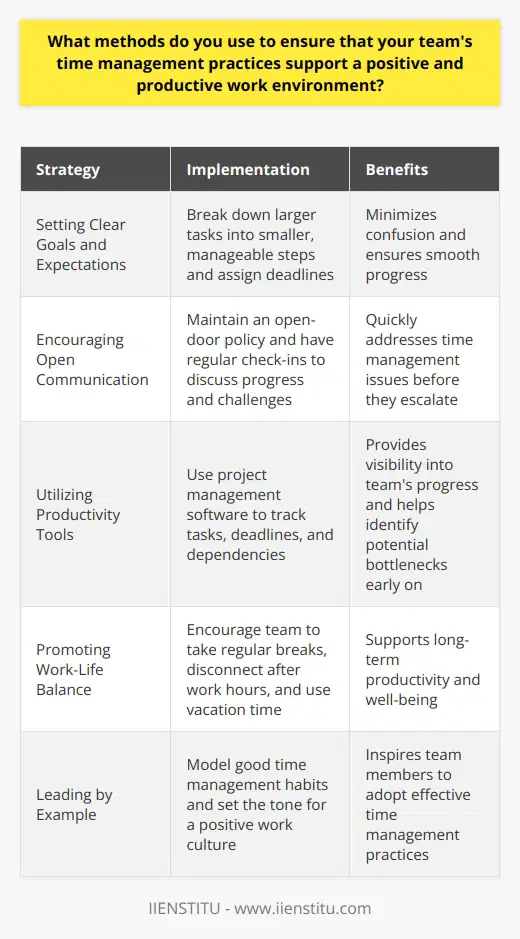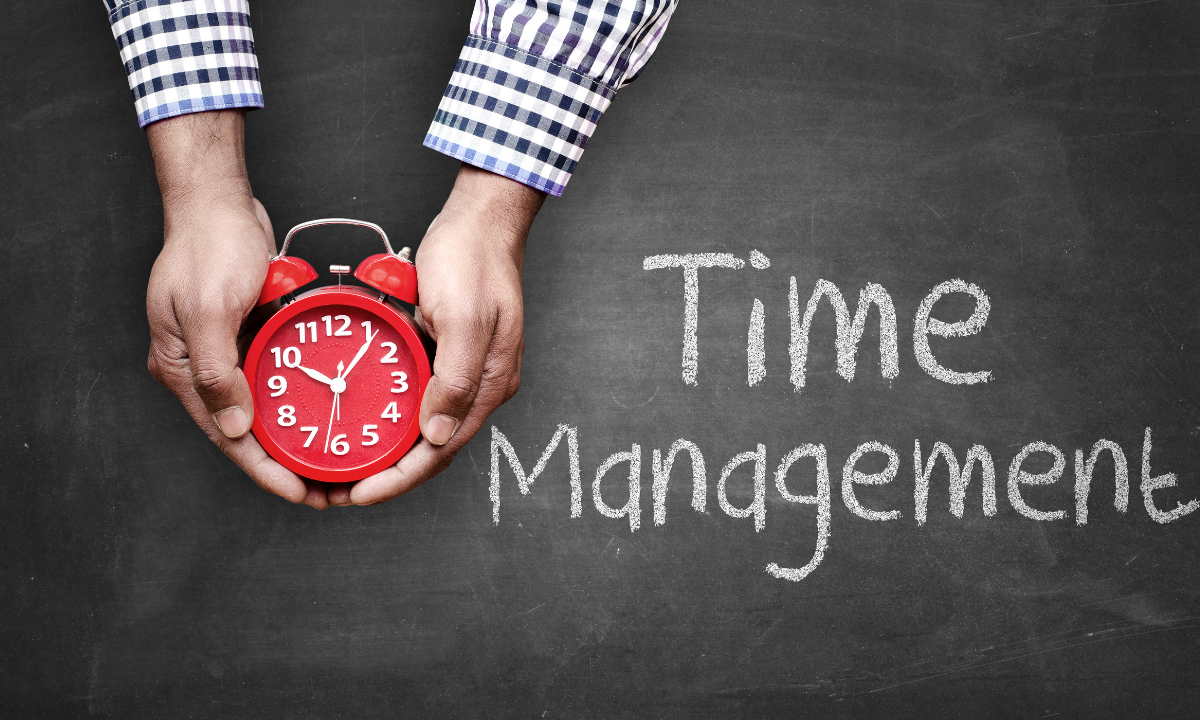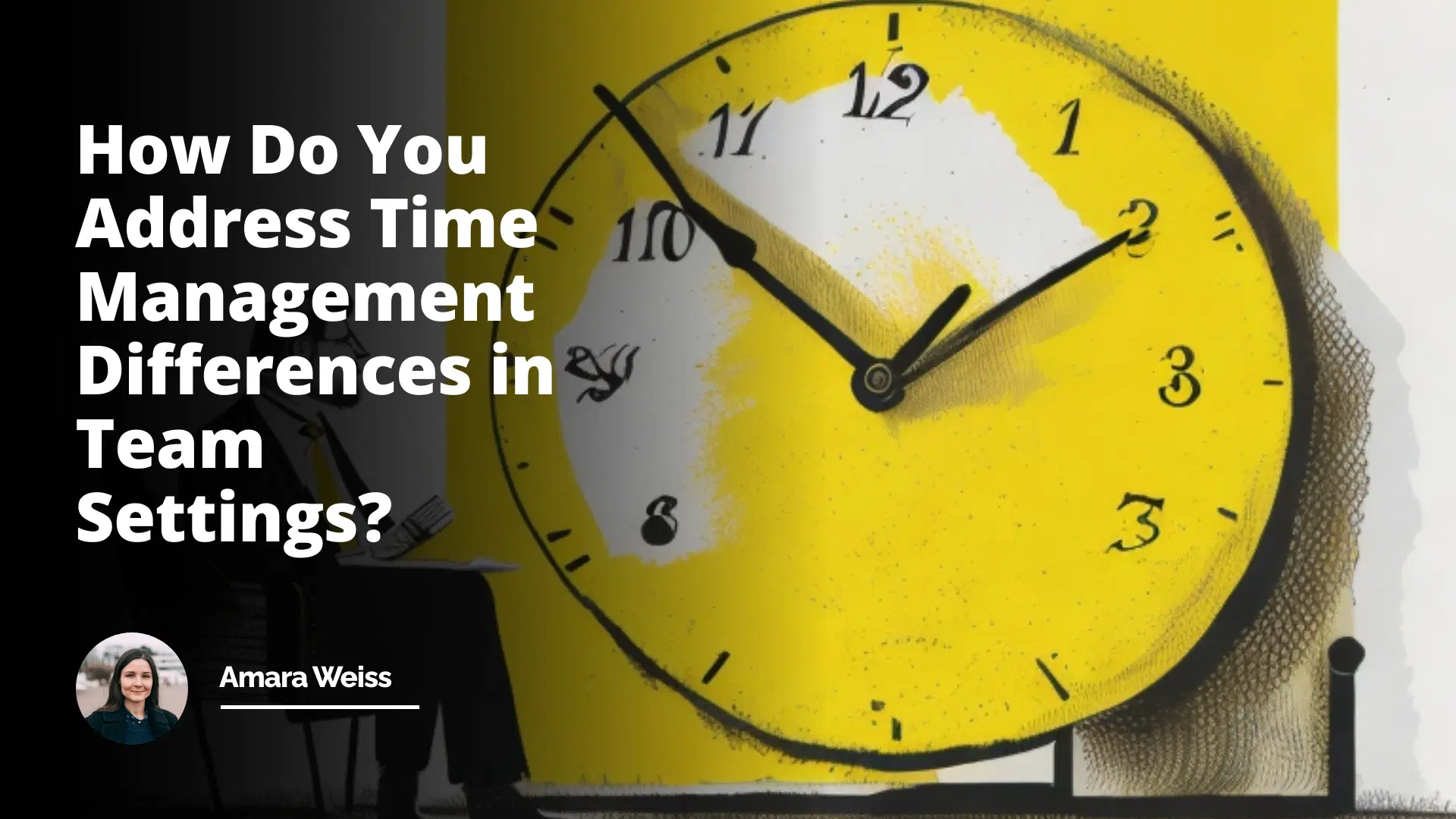
I remember the first time I led a team with varied time management styles; it was both exhilarating and downright challenging. We were tasked with delivering a critical project under a tight deadline, and I quickly realized that while everyone was committed, their approaches to managing time were as different as night and day. Some team members were early birds, firing on all cylinders at the crack of dawn, while others were night owls, hitting their stride after sunset. This stark difference got me thinking: How can one effectively deal with these variations in time management within a team?
Embracing Time Management Diversity in Teams
Time management holds a crucial role in any workforce, but the truth is, folks naturally handle their time differently. It's like herding cats sometimes! This diversity can be both a strength and a hurdle. Understanding and embracing these differences is essential for any leader aiming to foster a cohesive and productive team.
Long Tail Keyword Example: How To Answer Have You Used Analytics İn Logistics İnterview Question
İnterview Question What Hinders Your Problem Solving Strategies To Overcome Obstacles
Why Do Interviewers Ask About Handling Time Management Differences?
When interviewers pose the question, "How do you address time management differences in team settings?", they're not just making chit-chat. They’re assessing your leadership and team management skills, specifically your ability to navigate and harmonize diverse time management approaches within a team.
Interview Question: How Do You Integrate New Time Management Tools or Apps Into Your Routine?
Interview Question: What are the Challenges Faced in Redesigning a Supply Chain?
A proficient leader should possess the knowledge and skills required to integrate these distinctions for the betterment of overall team productivity. Team members often exhibit distinct peaks of productivity, work styles, and time allocation preferences. It's up to you to bring these pieces together into a harmonious workflow.
The Purpose Behind the Question
This question aims to evaluate several key competencies:
Conflict Resolution Abilities: Can you handle disagreements stemming from time management differences?
Adaptability: Are you flexible enough to adjust plans based on your team's varied time preferences?
Leadership Prowess: Do you have what it takes to guide diverse individuals towards a common goal?
Management Acumen: How proficient are you in orchestrating team dynamics to enhance productivity?
They want to see if you can cultivate an environment that celebrates diversity while maintaining effective team performance. In other words, can you make the team tick like a well-oiled machine despite the disparities?
At What Interview Level Is It Asked?
Typically, this question arises during mid-level or senior-level interviews, especially for supervisory or managerial roles that demand adeptness in team management. However, don't be surprised if it pops up in entry-level interviews, depending on the nature and demands of the role. After all, teamwork makes the dream work!
What Kind of Answer Is Expected?
The ideal response should incorporate real-world examples from your prior experiences where you successfully navigated time management differences within a team. Your answer should showcase:
Leadership Qualities
Problem-Solving Skills
Proficiency in Managing Teams
Essentially, it should reflect your comprehension of diverse working preferences and your ability to harmonize them to foster a productive team atmosphere.
Possible Answers to Consider
Here's an example of how you might respond:
"In my previous role, our team was comprised of individuals with varying working and time management styles. Some were early risers, while others were night owls. To reconcile these differences, I implemented a flexible work schedule, allowing team members to choose their working hours within a reasonable timeframe. We established core hours when everyone was expected to be available for collaborative activities and addressing urgent matters. This approach not only enhanced team cohesion but also significantly boosted our overall productivity."
What strategies can be employed to manage time differences among team members in a group setting?
In what ways can team dynamics be managed considering the varying time management skills of teammates?
Can you suggest any effective means to reconcile time management disparities within a team?
How can time differences be mitigated when working in a team-setting?
How do you handle disparities in time-keeping among team members?
Do you have any practical methods for addressing diverse time management abilities in a team setting?
What are the best ways to approach time management issues within a team?
How do you deal with the different time management approaches of individuals within a team?
What methods can be applied to harmonize time management styles in a team environment?
Are there any proven techniques to manage the various time management habits of team members?
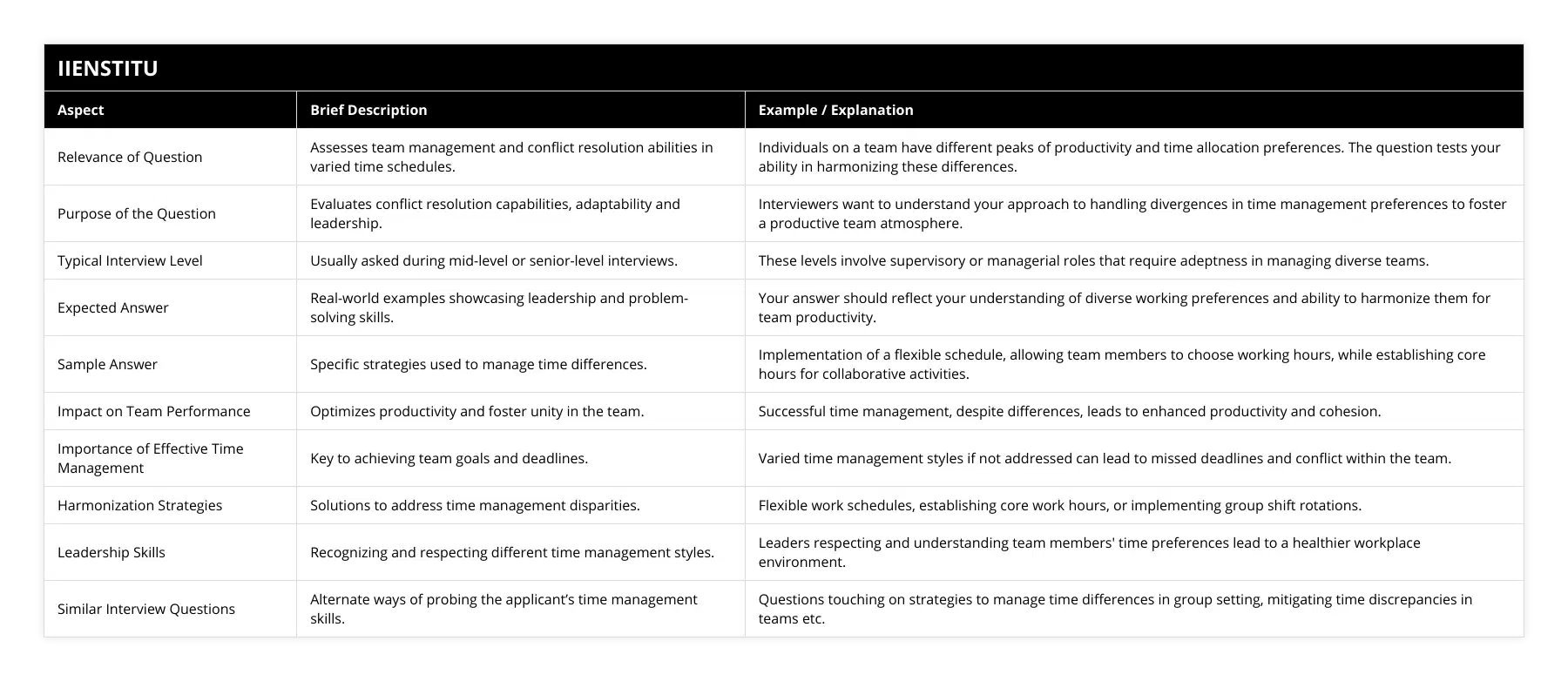
This response demonstrates your ability to manage diverse time management styles, implement strategies for team time management, and shows a proactive approach to improving team productivity through time management.
Strategies to Harmonize Different Time Management Styles
Over the years, I've discovered several strategies that can help in harmonizing time management preferences within a team:
1- Implement Flexible Scheduling: Allow team members to work during their most productive hours. This flexibility can increase job satisfaction and efficiency.
2- Establish Core Hours: Set specific times during the day when everyone is expected to be available. This ensures essential collaboration and communication occur seamlessly.
3- Utilize Collaborative Tools: Tools like Slack, Trello, or Asana help keep everyone on the same page, regardless of their individual schedules.
4- Set Clear Deadlines and Expectations: Clearly defined goals and timelines help team members manage their time effectively.
5- Encourage Open Communication: Create an environment where team members feel comfortable discussing their time management needs.
Utilizing Critical Path Method in Managing Time Variations
In one project, we adopted the critical path method project management strategy to align our team's efforts effectively. This method helped us identify critical tasks and their dependencies, ensuring that regardless of individual schedules, the project's essential components stayed on track. By focusing on the critical path, we could coordinate tasks efficiently, even when dealing with varied time management styles.
Dealing with Challenges
Despite best efforts, challenges are bound to arise when managing a team with diverse time management styles. Here are some common hurdles and how to overcome them:
Communication Gaps
Solution: Use asynchronous communication tools and ensure all updates are documented. This keeps everyone in the loop, even if they're not working simultaneously.
Scheduling Conflicts
Solution: Rotate meeting times and use shared calendars to accommodate different schedules. Tools like Doodle can help find the best times for everyone.
Perceived Inequities
Solution: Maintain transparency about scheduling policies and ensure that workload distribution is fair. Regular check-ins can help address any concerns promptly.
The Impact on Team Performance
Addressing time management differences effectively can lead to:
Enhanced Productivity
Improved Morale
Better Work-Life Balance
Increased Team Cohesion
By fostering an environment that respects individual time management styles, you're more likely to see your team thrive.
Leadership and Time Management in Teams
Being a leader means more than just delegating tasks; it involves understanding and accommodating the diverse time management styles within your team. It's about creating a culture where everyone feels valued and is given the tools to succeed.
Practical Methods for Addressing Time Management Differences
Conduct Individual Assessments: Understand each team member's peak productivity times.
Tailor Assignments Accordingly: Align tasks with individual strengths and schedules.
Promote Self-Management: Encourage team members to take ownership of their time management.
Provide Resources: Offer training or tools to help improve time management skills.
The Role of Communication in Harmonizing Time Management
Communication is the lifeblood of any team, especially when time management differences are at play. Open dialogues about schedules, workloads, and expectations can prevent misunderstandings and promote a collaborative atmosphere.
Encouraging Open Communication
Regular Check-Ins: Schedule one-on-one meetings to discuss any concerns.
Team Meetings: Use these sessions to address collective challenges and brainstorm solutions.
Anonymous Feedback: Provide a platform for team members to voice concerns they may not feel comfortable sharing openly.
Personal Reflections on Managing Time Variations
Reflecting on my own journey, I realized that flexibility and empathy are key. For instance, when managing a team spread across different time zones, I had to adapt my management style significantly. Embracing asynchronous communication and setting clear expectations were game-changers.
Leveraging Technology
Modern technology offers solutions that make managing time differences more manageable:
Project Management Tools: Keep track of tasks and progress.
Communication Platforms: Facilitate real-time and asynchronous communication.
Scheduling Apps: Simplify the process of finding convenient meeting times.
Conclusion
Dealing with variations in time management within a team is a complex but rewarding challenge. By embracing diversity, fostering open communication, and implementing strategic solutions, you can turn potential obstacles into opportunities for growth.
Remember, your ability to manage these differences not only enhances team performance but also showcases your leadership skills—a quality that won't go unnoticed by prospective employers.
Similar Interview Questions
To prepare thoroughly, consider these similar questions:
What strategies can be employed to manage time differences among team members in a group setting?
How can team dynamics be managed considering the varying time management skills of teammates?
Can you suggest any effective means to reconcile time management disparities within a team?
How do you handle disparities in time-keeping among team members?
What methods can be applied to harmonize time management styles in a team environment?
References
1- Project Management Institute. A Guide to the Project Management Body of Knowledge (PMBOK Guide). 6th ed., Project Management Institute, 2017.
2- Katzenbach, Jon R., and Douglas K. Smith. The Wisdom of Teams: Creating the High-Performance Organization. Harvard Business Review Press, 1993.
3- Covey, Stephen R. The 7 Habits of Highly Effective People: Powerful Lessons in Personal Change. Simon & Schuster, 1989.
4- Goleman, Daniel. Emotional Intelligence: Why It Can Matter More Than IQ. Bantam Books, 1995.
5- Drucker, Peter F. The Effective Executive. HarperCollins, 1967.
By understanding and addressing time management differences, you not only enhance your team's productivity but also grow as a leader. So, when faced with this question in an interview, you'll be ready to shine!
Frequently Asked Questions
How do you prioritize tasks when working with a team?
When working with a team, I prioritize tasks based on their importance and urgency. I consider the project's overall goals and deadlines to determine which tasks are most critical.
Communicate with Team Members
I actively communicate with my team members to understand their workload and availability. This helps me assign tasks efficiently and ensures everyone is on the same page.
Use Project Management Tools
I utilize project management tools like Trello or Asana to create task lists and set deadlines. These tools help me visually organize and track the progress of each task.
Be Flexible and Adaptable
I remain flexible and adaptable when prioritizing tasks. If a new urgent task arises or priorities shift, I quickly reassess and adjust my task list accordingly.
Regularly Review and Adjust
I regularly review the status of tasks and make adjustments as needed. This allows me to ensure that the team is progressing towards the project's goals and identify any potential bottlenecks.
In my previous role at XYZ Company, I successfully led a cross-functional team to launch a new product. By effectively prioritizing tasks and collaborating with team members, we met all our milestones and delivered the project on time.
I believe that clear communication, flexibility, and regular review are key to successfully prioritizing tasks when working with a team. By keeping these principles in mind, I can contribute to the team's productivity and achieve our shared objectives.
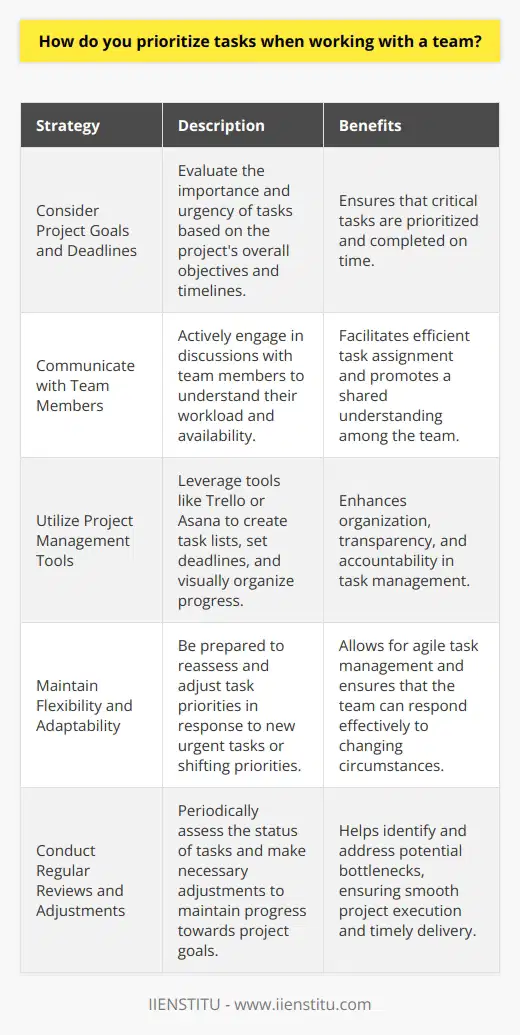
What strategies do you use to ensure everyone in the team is on the same page regarding deadlines?
I firmly believe that clear communication is key to ensuring everyone in the team meets deadlines. I make it a point to discuss expectations and timelines with each team member individually. This helps me understand their workload and any potential obstacles they may face.
Regular Check-Ins
I schedule regular check-ins with the team to track progress and address any issues that arise. These meetings provide an opportunity for everyone to share updates, ask questions, and collaborate on solutions. I find that frequent, open dialogue keeps us all aligned and motivated.
Breaking Down Projects
When working on complex projects, I break them down into smaller, manageable tasks with specific due dates. This approach makes the overall timeline more achievable and allows team members to focus on one step at a time. It also helps me identify potential bottlenecks early on and adjust the schedule if needed.
Utilizing Project Management Tools
I'm a big proponent of using project management software to keep everyone organized and accountable. These tools allow us to assign tasks, set deadlines, and track progress in real-time. They also provide a centralized place for storing documents and facilitating communication among team members.
Leading by Example
Ultimately, I believe in leading by example when it comes to meeting deadlines. I make sure to complete my own tasks on time and communicate any challenges I encounter along the way. By demonstrating reliability and transparency, I set the tone for the rest of the team to follow suit.
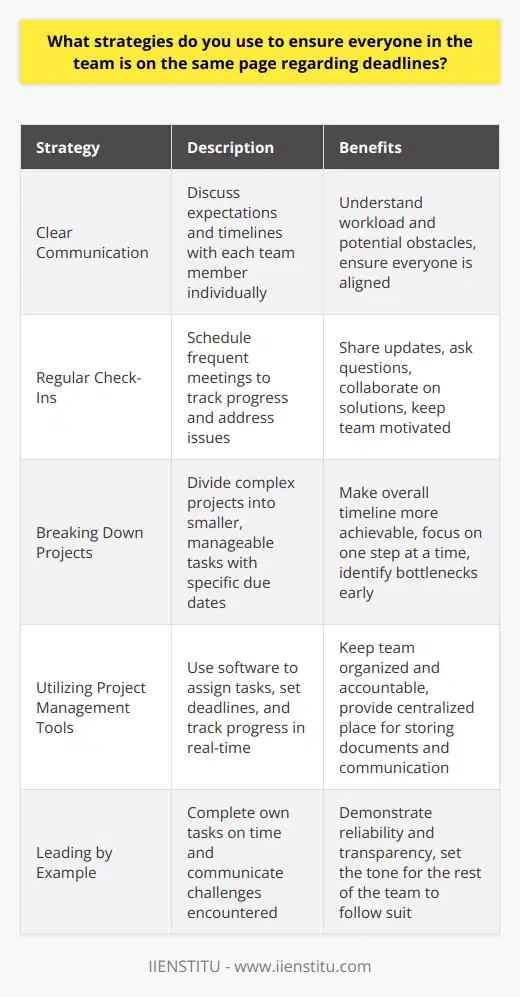
How do you handle team members who consistently miss deadlines?
When team members consistently miss deadlines, it's essential to address the issue promptly and professionally. Here are some strategies I employ to handle such situations:
Identify the Root Cause
I start by having an open and honest conversation with the team member. I listen actively to understand their perspective and the reasons behind the missed deadlines. Sometimes, there might be underlying issues like personal problems, lack of clarity, or competing priorities that need to be addressed.
Set Clear Expectations
I ensure that everyone on the team understands the project goals, timelines, and their individual responsibilities. I break down tasks into smaller, manageable chunks and set realistic deadlines. Regular check-ins help keep everyone on track and identify potential roadblocks early on.
Provide Support and Resources
If a team member is struggling, I offer support and resources to help them succeed. This might include additional training, mentoring, or reallocating tasks to better match their skills and strengths. I believe in creating a collaborative and supportive team environment where everyone can thrive.
Hold Accountability
While I'm empathetic to individual circumstances, I also hold team members accountable for their commitments. If missed deadlines become a pattern, I address it directly and work with the team member to create an improvement plan. I set clear consequences and follow through if the situation doesn't improve.
Ultimately, my approach is to foster a culture of open communication, collaboration, and accountability. By addressing issues proactively and supporting my team members, I aim to minimize missed deadlines and ensure project success.
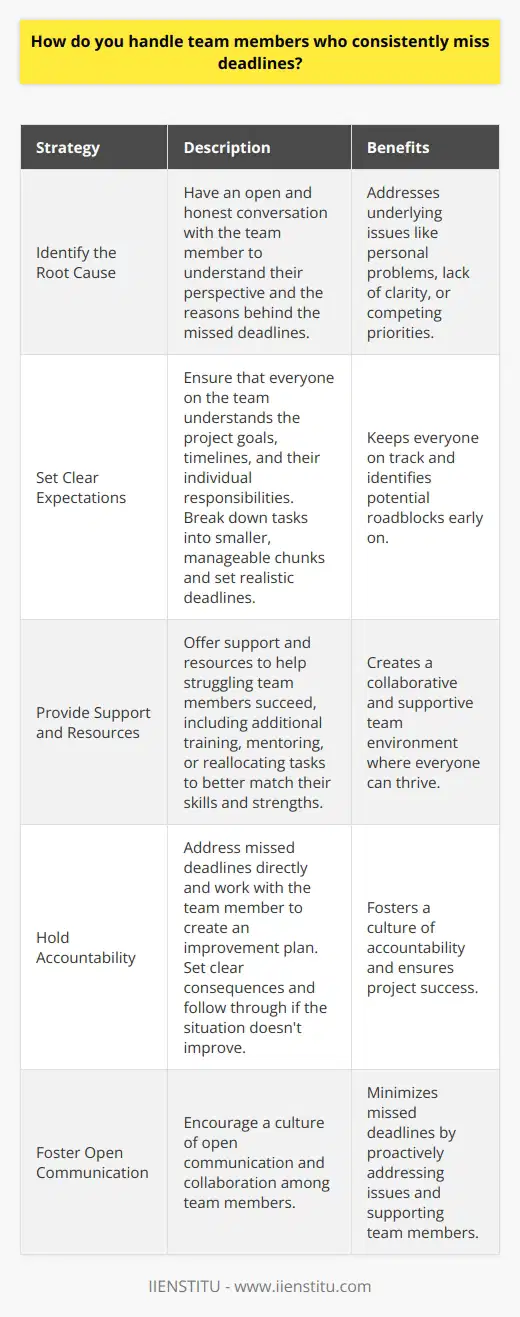
What techniques do you employ to keep your team motivated and focused on time-sensitive tasks?
As a team leader, I employ several techniques to keep my team motivated and focused on time-sensitive tasks. One of the most effective methods is setting clear goals and expectations from the outset. I make sure everyone understands their roles and responsibilities, as well as the deadlines we need to meet.
Communication is Key
I believe that regular communication is essential for keeping the team on track. I schedule frequent check-ins, either in person or via video chat, to discuss progress, identify any obstacles, and brainstorm solutions together. This helps us stay aligned and ensures that everyone feels heard and supported.
Celebrating Milestones
Another technique I use is celebrating milestones along the way. When we achieve a significant goal or complete a challenging task, I make sure to recognize the team's hard work and dedication. This could be as simple as sending a heartfelt email or treating everyone to lunch. Acknowledging these successes boosts morale and motivation.
Leading by Example
I also believe in leading by example. I strive to maintain a positive attitude, even when faced with tight deadlines or unexpected setbacks. By remaining calm and focused, I set the tone for the rest of the team. I roll up my sleeves and work alongside them, showing that we're all in this together.
Encouraging Work-Life Balance
Finally, I recognize the importance of work-life balance, especially during high-pressure periods. I encourage my team members to take breaks when needed, prioritize self-care, and communicate if they're feeling overwhelmed. By creating a supportive and understanding environment, we can tackle time-sensitive tasks without burning out.
At the end of the day, keeping a team motivated and focused requires a combination of clear communication, recognition, leading by example, and prioritizing well-being. It's a continuous process, but one that I find incredibly rewarding as we accomplish our goals together.
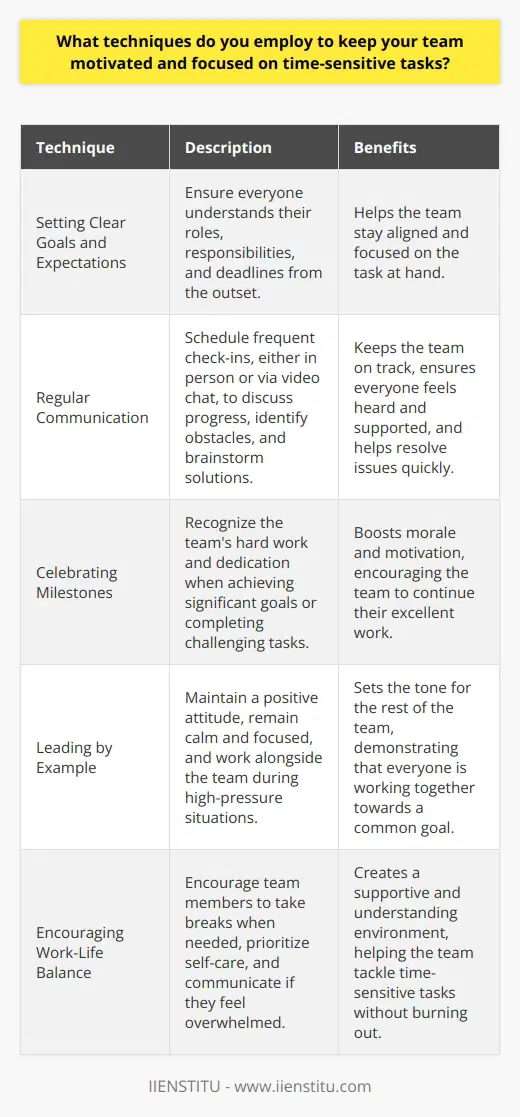
How do you address conflicts that arise due to differences in time management styles within your team?
When addressing conflicts due to differences in time management styles within my team, I first seek to understand each team member's perspective and approach. By actively listening and asking questions, I gain insights into their priorities, challenges, and preferred working methods.
Foster Open Communication
I encourage open and honest communication among team members. We discuss our individual time management strategies and how they impact the team's overall workflow. Through constructive dialogue, we identify areas of alignment and potential friction points.
Establish Clear Expectations and Deadlines
To mitigate conflicts, I work with the team to establish clear expectations and realistic deadlines for each task and project. We break down larger goals into smaller, manageable milestones, ensuring everyone understands their responsibilities and the timeline for completion.
Adapt and Compromise
I believe in the power of adaptability and compromise. When conflicts arise, I encourage team members to find common ground and explore alternative approaches that accommodate different time management styles. We may need to adjust our individual preferences for the greater good of the team.
Lead by Example
As a team leader, I strive to lead by example. I demonstrate effective time management practices, such as prioritizing tasks, managing distractions, and meeting deadlines consistently. By setting a positive example, I inspire and motivate my team members to adopt similar habits.
Continuously Review and Improve
Resolving time management conflicts is an ongoing process. I schedule regular check-ins and retrospective meetings to assess our progress, identify areas for improvement, and make necessary adjustments. We celebrate successes, learn from challenges, and continuously refine our approach to time management as a team.
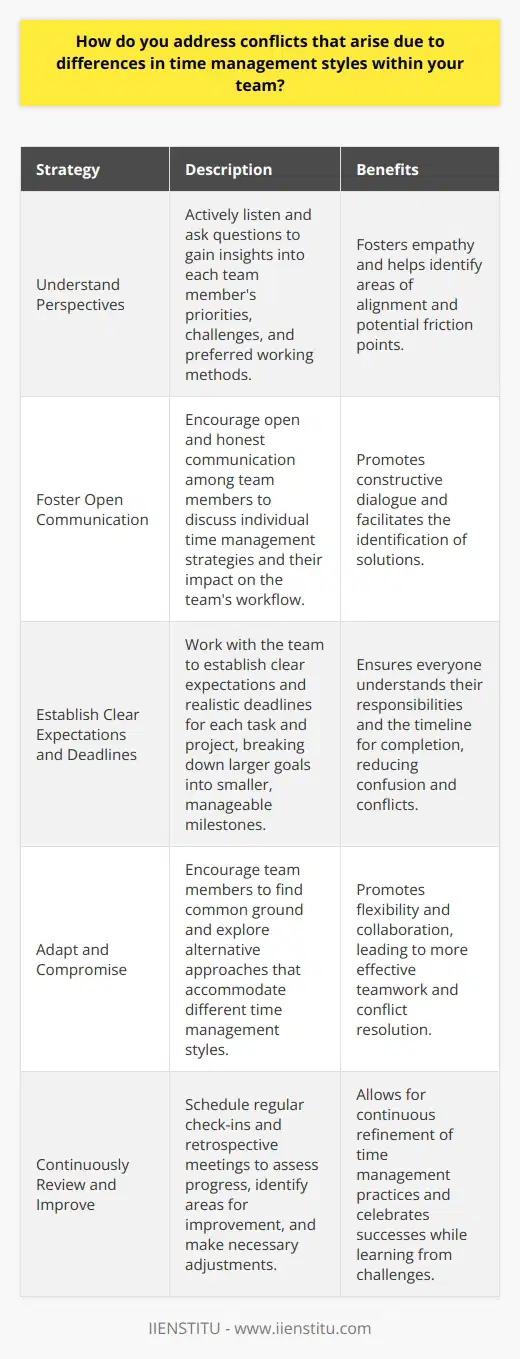
What tools or technologies do you use to streamline team collaboration and time management?
As a project manager, I rely on several tools and technologies to streamline team collaboration and time management:
Communication Tools
I've found that using messaging apps like Slack helps keep everyone on the same page. It allows for quick check-ins and updates without lengthy emails. For more in-depth discussions, I prefer video calls using Zoom or Microsoft Teams.
Project Management Software
To keep projects organized and on track, I use Asana. It's great for assigning tasks, setting deadlines, and tracking progress. I also like how it integrates with other tools we use, such as Google Drive.
Time Tracking and Productivity Apps
To ensure we're using our time efficiently, I have the team track their hours using Toggl. It provides valuable insights into how we're spending our time. I also encourage the use of productivity techniques like the Pomodoro method to maintain focus.
File Sharing and Collaboration
For seamless file sharing and collaboration, we rely on cloud-based platforms like Google Drive and Dropbox. They allow for real-time editing and commenting, reducing the need for back-and-forth emails.
Ultimately, the key is finding the right combination of tools that work for your team's specific needs. It takes some trial and error, but once you find that sweet spot, it can make a world of difference in productivity and collaboration.
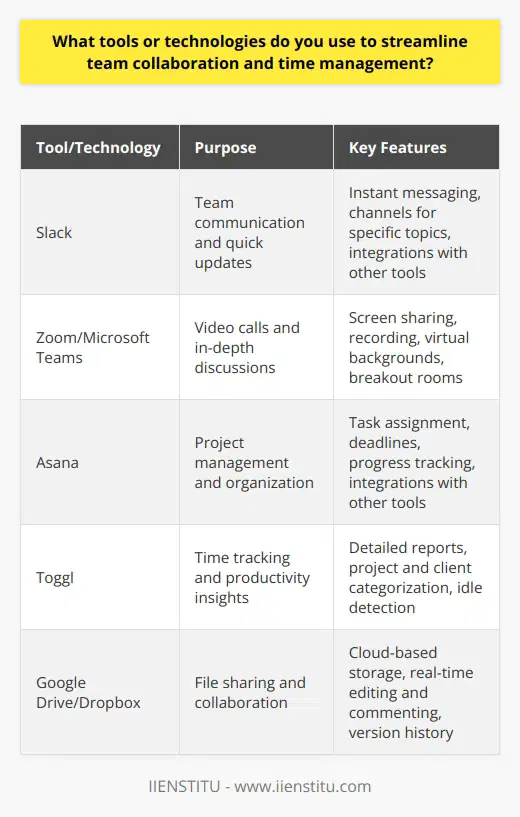
How do you ensure that your team's workload is balanced and everyone is contributing equally?
As a team leader, I believe in fostering open communication and collaboration among team members. I regularly meet with each team member individually to discuss their workload, challenges, and goals. This helps me understand their capacity and identify any potential issues early on.
Encouraging Transparency and Accountability
During our weekly team meetings, I encourage everyone to share their progress, successes, and roadblocks. This transparency allows us to celebrate wins together and support each other through difficulties. It also promotes a sense of accountability, as everyone is aware of their teammates' contributions.
Leveraging Strengths and Interests
I take the time to learn about each team member's strengths, skills, and interests. When assigning tasks, I try to match them with projects that align with their abilities and passions. This not only ensures a more balanced workload but also boosts motivation and engagement.
Continuously Monitoring and Adjusting
Throughout the week, I keep an eye on everyone's progress and proactively reach out if I notice someone struggling or falling behind. If necessary, I redistribute tasks or provide additional support to maintain a balanced workload across the team.
Ultimately, my goal is to create a supportive and collaborative environment where everyone feels valued and empowered to contribute their best work. By fostering open communication, leveraging strengths, and continuously monitoring progress, I strive to ensure that our team's workload is balanced and everyone is contributing equally to our success.
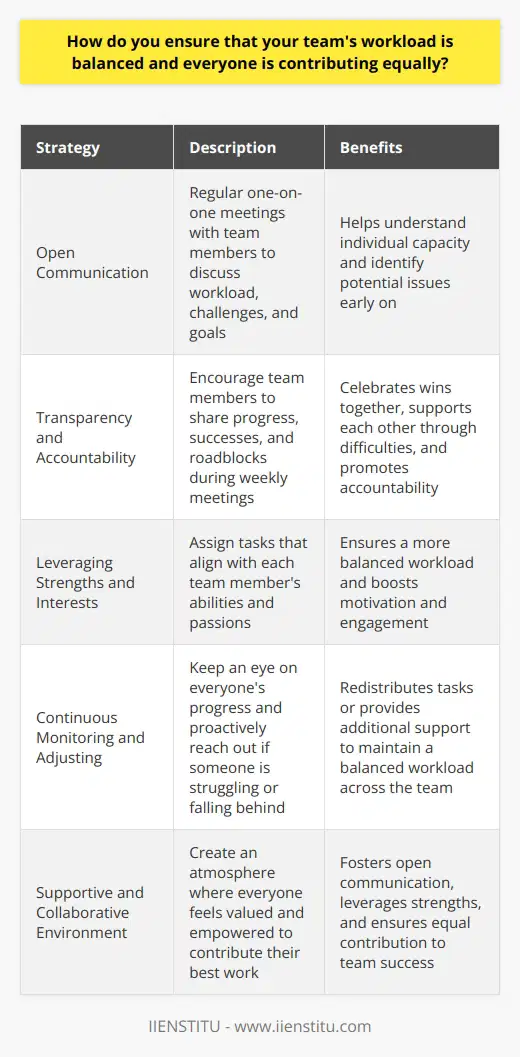
What steps do you take to create a sense of urgency when necessary, without causing undue stress?
When creating a sense of urgency, I first clearly communicate the importance and deadline of the task. I break down the project into smaller, manageable steps with specific timelines for each phase. This helps team members understand their responsibilities and stay on track.
Prioritizing Tasks
I prioritize tasks based on their impact and urgency. High-priority items are tackled first, ensuring that critical deadlines are met. Regular check-ins with the team help identify any roadblocks and provide support where needed.
Leading by Example
I lead by example, demonstrating a sense of urgency in my own work. When team members see their leader working diligently towards a goal, they are more likely to follow suit. I maintain a positive attitude and encourage open communication to address any concerns or stress points.
Celebrating Milestones
Celebrating milestones along the way keeps the team motivated and focused. Recognizing progress and achievements boosts morale and reinforces the importance of meeting deadlines. Small rewards or gestures of appreciation can go a long way in keeping spirits high.
By breaking down tasks, prioritizing effectively, leading by example, and celebrating successes, I create a sense of urgency without overwhelming the team. This approach has helped me consistently meet deadlines while maintaining a positive work environment.
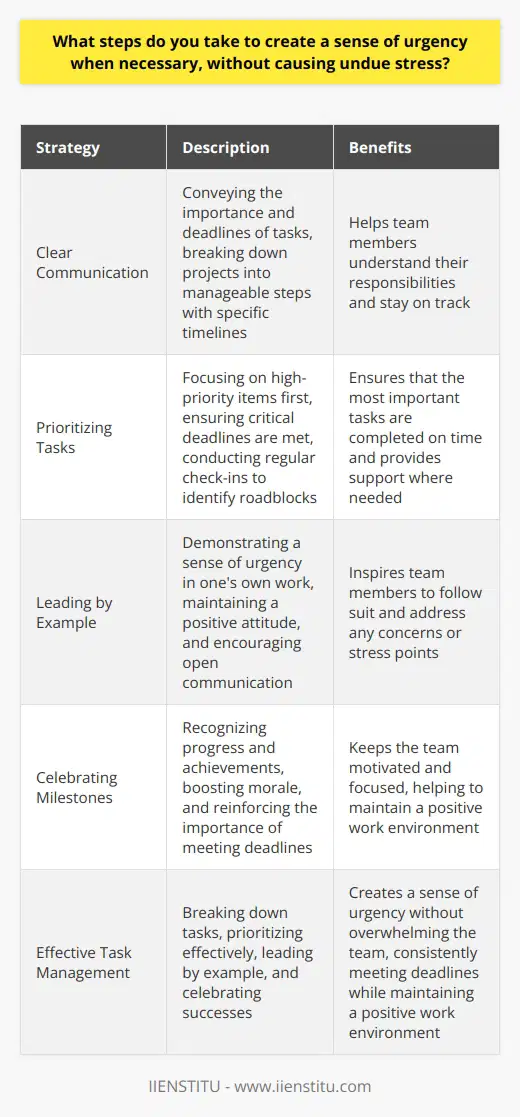
How do you foster a culture of accountability and responsibility within your team regarding time management?
I believe that fostering a culture of accountability and responsibility within a team is crucial for effective time management. It starts with clearly communicating expectations and deadlines to every team member. This ensures that everyone understands their roles and the importance of meeting timelines.
Lead by Example
As a leader, I strive to lead by example. I make sure to manage my own time effectively and meet my commitments. By demonstrating accountability myself, I inspire my team to do the same. When team members see their leader taking responsibility seriously, they are more likely to follow suit.
Regular Check-Ins
I schedule regular check-ins with my team members to discuss progress, challenges, and any support they need. These check-ins provide an opportunity to address any time management issues early on. We work together to find solutions and make adjustments as needed. By staying engaged and supportive, I help my team stay on track.
Celebrate Successes
When team members demonstrate exceptional accountability and meet important deadlines, I make sure to celebrate their successes. Public recognition, whether it's during team meetings or through company-wide announcements, reinforces the importance of responsibility. It also motivates others to strive for the same level of accountability.
Continuous Improvement
I encourage my team to continuously improve their time management skills. We regularly discuss best practices and share tips with each other. I also provide resources, such as time management tools or training opportunities, to support their growth. By fostering a culture of continuous improvement, we can optimize our productivity and deliver better results.
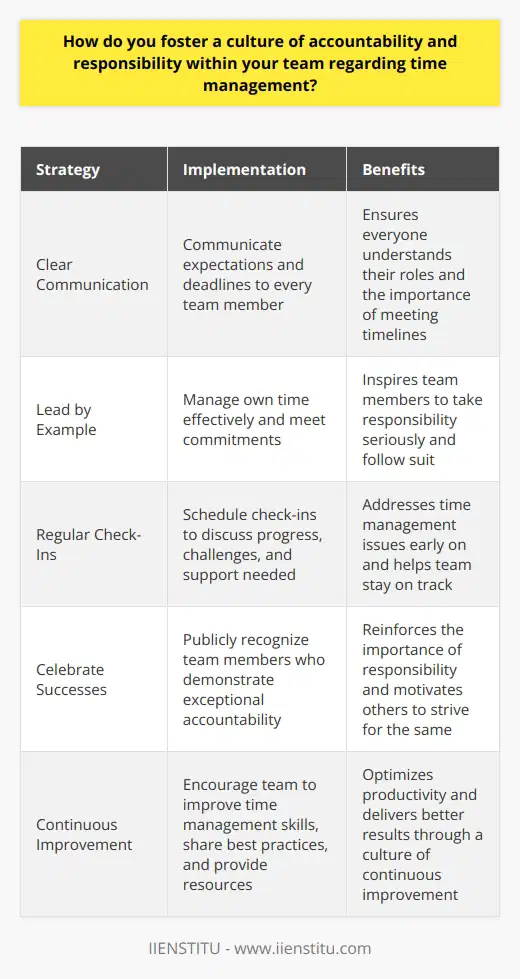
What methods do you use to track progress and ensure that projects are completed on time?
I use a combination of methods to track progress and ensure timely project completion. Here are some key strategies:
Set Clear Milestones and Deadlines
I break projects down into smaller, manageable tasks with specific due dates. This helps me stay focused and motivated. I remember one time when this approach saved my team from missing a crucial client deadline.
Regular Check-Ins and Updates
I schedule frequent check-ins with my team to assess progress, identify obstacles, and brainstorm solutions. Open communication is essential! These meetings also provide opportunities to celebrate small wins along the way.
Utilize Project Management Tools
I'm a big fan of using software like Trello or Asana to visualize workflows, assign tasks, and track progress. These tools keep everyone on the same page and help me spot potential roadblocks early on.
Prioritize and Adapt as Needed
Sometimes unexpected challenges arise, and that's okay! I try to stay flexible and re-prioritize tasks if necessary. It's all about keeping the end goal in mind while being adaptable in my approach.
At the end of the day, I believe that a proactive, organized, and collaborative mindset is key to successfully managing projects and delivering quality work on schedule. I'm always looking for ways to improve my process and welcome feedback from my team.
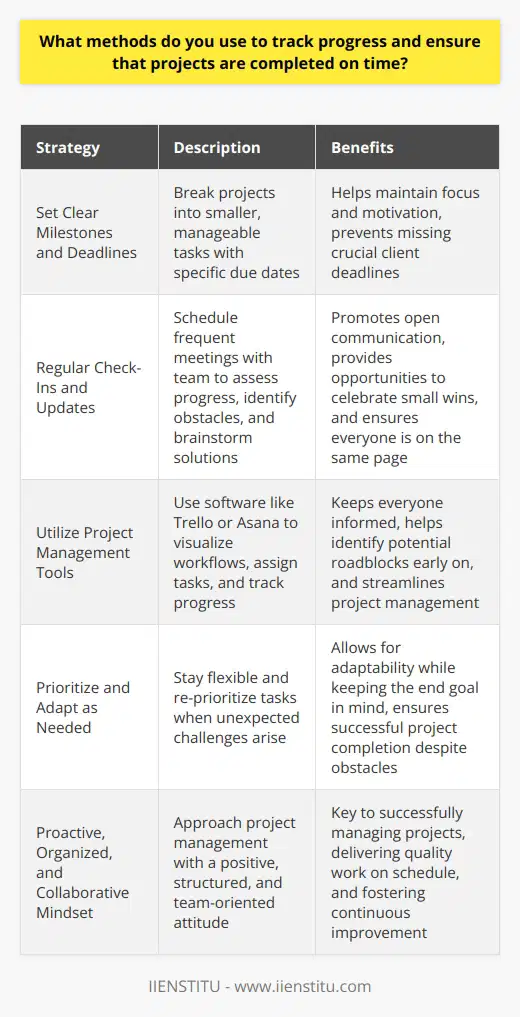
How do you handle situations where a team member's poor time management affects the entire team's performance?
When faced with a team member's poor time management affecting the team's performance, I take a proactive approach. First, I initiate a one-on-one conversation with the individual to understand the root cause of the issue. Together, we identify any challenges they're facing and brainstorm solutions to overcome them.
Setting Clear Expectations and Deadlines
I work with the team member to set clear expectations and deadlines for their tasks. We break down larger projects into smaller, manageable milestones to make progress tracking easier. I also encourage them to communicate any roadblocks they encounter promptly, so we can address them before they impact the team's progress.
Providing Support and Resources
If the team member lacks certain skills or knowledge, I connect them with relevant resources or training opportunities. I believe in empowering team members to succeed by providing the necessary support and tools. Sometimes, a little guidance and encouragement can go a long way in improving their time management skills.
Monitoring Progress and Adjusting Workload
I closely monitor the team member's progress and check in with them regularly to ensure they're on track. If needed, I'm open to adjusting their workload or reassigning tasks to other team members to maintain the team's overall productivity. It's essential to find a balance that allows the individual to improve while minimizing the impact on the team.
Leading by Example and Fostering Accountability
As a team leader, I strive to lead by example when it comes to time management. I prioritize tasks, meet deadlines, and communicate effectively with the team. By demonstrating good time management practices, I set the standard for the team to follow. Additionally, I foster a culture of accountability where everyone takes responsibility for their work and supports each other in achieving our shared goals.
Ultimately, handling poor time management within a team requires a combination of communication, support, and adaptability. By addressing the issue head-on, providing necessary resources, and monitoring progress, I aim to help the team member improve their time management skills while ensuring the team's overall success.
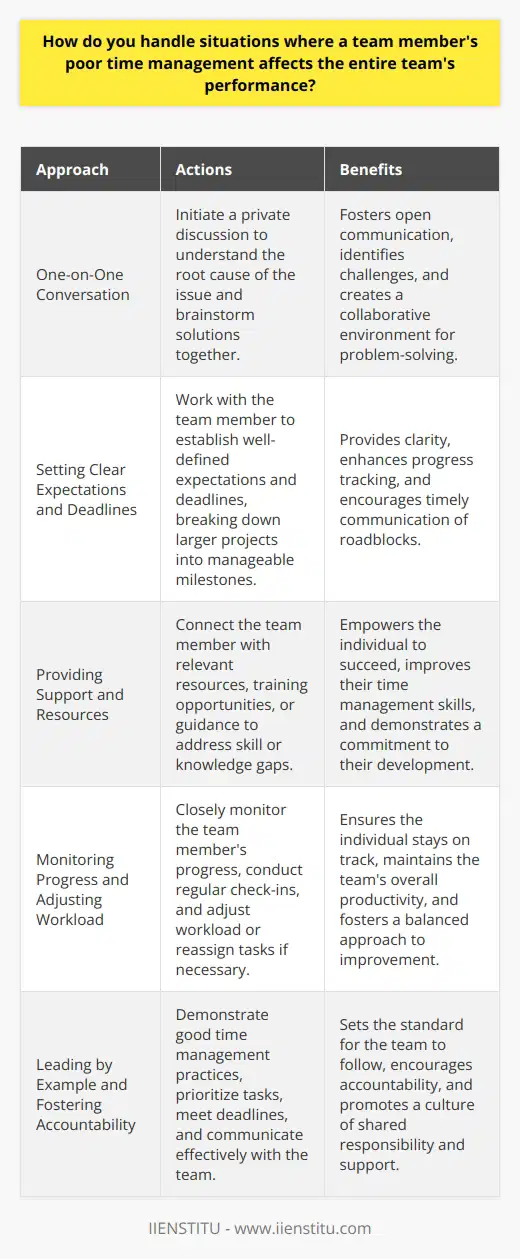
What strategies do you implement to prevent burnout and maintain a healthy work-life balance for your team?
As a leader, I prioritize the well-being of my team members. I believe that preventing burnout and maintaining a healthy work-life balance is crucial for their productivity and job satisfaction.
Encouraging Time Off
I encourage my team to take regular time off to recharge and spend time with their loved ones. Whether it's a long weekend or a full vacation, I make sure they know that taking breaks is not only allowed but encouraged.
Flexible Work Arrangements
I understand that everyone has different needs and responsibilities outside of work. That's why I offer flexible work arrangements, such as remote work options and adjustable schedules, to help my team members balance their work and personal lives.
Promoting Open Communication
I foster an open and supportive work environment where team members feel comfortable sharing their concerns and challenges. I regularly check in with each individual to ensure they're not feeling overwhelmed and to offer support when needed.
Encouraging Hobbies and Interests
I believe that having hobbies and interests outside of work is essential for maintaining a healthy work-life balance. I encourage my team to pursue their passions and share their experiences with each other, creating a sense of camaraderie and mutual support.
By implementing these strategies, I've seen firsthand how a happy and balanced team can lead to increased productivity, creativity, and overall success for the company.
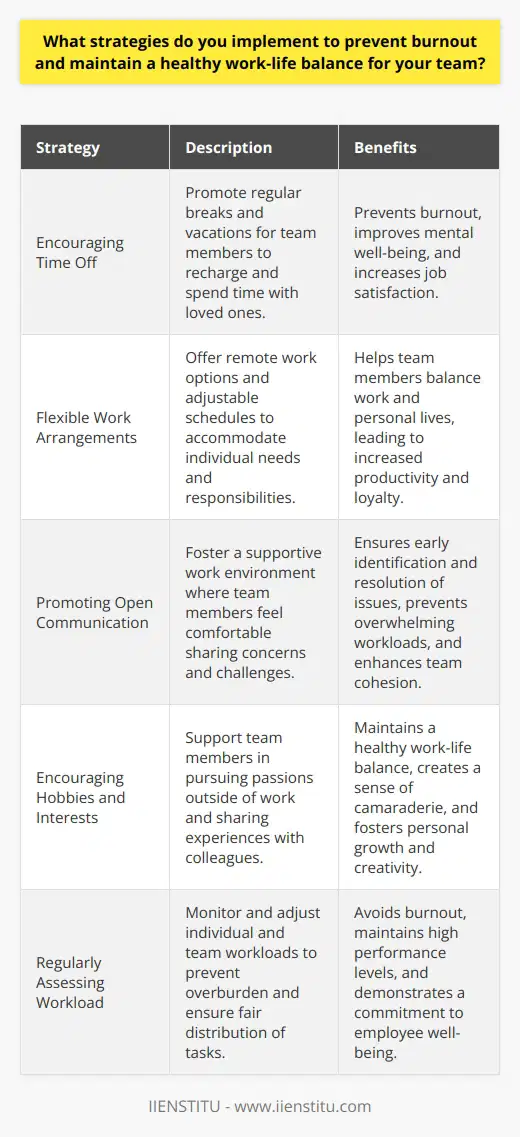
How do you adapt your time management approach to accommodate different working styles within your team?
When it comes to adapting my time management approach to accommodate different working styles within my team, I believe in open communication and flexibility. I make a point to have regular check-ins with each team member to understand their preferred working style and any challenges they may be facing.
Tailoring My Approach
Based on these conversations, I tailor my management style to best support each individual. For example, when working with a team member who thrives on structure and deadlines, I make sure to provide clear timelines and regular progress updates. On the other hand, for someone who prefers more autonomy, I give them the space to work independently while still being available for guidance when needed.
Encouraging Collaboration
I also believe in fostering a collaborative team environment where everyone feels comfortable sharing their ideas and feedback. I encourage team members to learn from each other's strengths and working styles, and I facilitate opportunities for cross-functional collaboration whenever possible.
Leading by Example
Ultimately, I believe that as a manager, it's my responsibility to lead by example when it comes to adaptability and flexibility. I strive to be open-minded, patient, and willing to adjust my own working style as needed to support the success of my team.
By taking a tailored approach to time management that accommodates the diverse needs and preferences of my team members, I've found that we're able to work more efficiently, collaboratively, and successfully together.
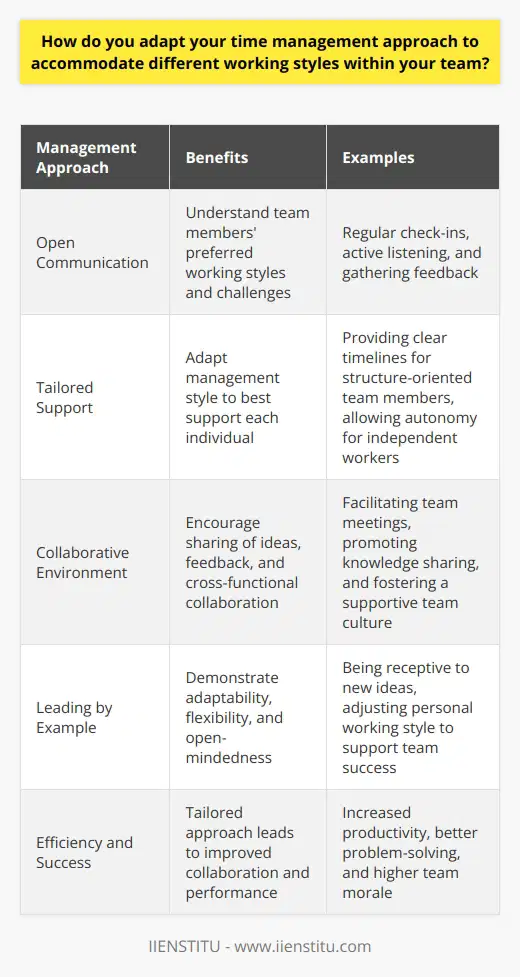
What techniques do you use to break down complex projects into manageable tasks with clear deadlines?
When faced with a complex project, I break it down into smaller, manageable tasks. This helps me stay organized and focused, ensuring that I can complete the project efficiently and effectively.
Creating a Project Plan
I start by creating a comprehensive project plan. I identify all the tasks required to complete the project and estimate the time needed for each task. This gives me a clear overview of the project scope and helps me set realistic deadlines.
Prioritizing Tasks
Next, I prioritize the tasks based on their importance and dependencies. I focus on the most critical tasks first, ensuring that I tackle any potential roadblocks early on. This approach allows me to maintain momentum and keeps the project moving forward.
Setting Milestones and Deadlines
I set clear milestones and deadlines for each task. This helps me stay on track and ensures that I'm making steady progress. I also build in some buffer time to account for any unexpected challenges that may arise.
Regularly Reviewing Progress
Throughout the project, I regularly review my progress. I check in with myself and my team to ensure that we're meeting our milestones and deadlines. If I encounter any issues or delays, I quickly adapt my plan and communicate any changes to the relevant stakeholders.
By breaking down complex projects into manageable tasks, setting clear deadlines, and regularly reviewing progress, I'm able to deliver high-quality work on time and within budget. This approach has served me well in my previous roles, and I'm confident that it will enable me to excel in this position as well.
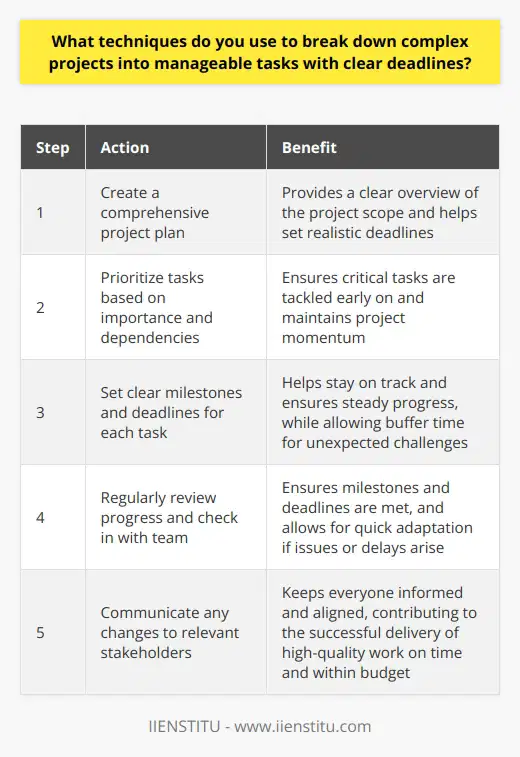
How do you ensure that your team members have the necessary resources and support to meet their time commitments?
As a team leader, I understand the importance of ensuring that my team members have the necessary resources and support to meet their deadlines. Here are some strategies I use:
Regular Check-Ins
I schedule regular one-on-one meetings with each team member to discuss their progress, challenges, and resource needs. During these check-ins, I actively listen to their concerns and provide guidance and support.
Collaborative Planning
I involve my team in the planning process, encouraging them to share their ideas and concerns. Together, we identify potential obstacles and develop strategies to overcome them, ensuring that everyone has the resources they need to succeed.
Resource Allocation
I work closely with upper management and other departments to secure the necessary resources for my team. Whether it's additional staff, equipment, or budget, I advocate for my team's needs to ensure they have what they require to meet their goals.
Skill Development
I believe in investing in my team's growth and development. I provide opportunities for training, workshops, and mentoring to help them acquire new skills and knowledge, which not only benefits their current projects but also prepares them for future challenges.
Flexibility and Adaptability
I recognize that unexpected challenges can arise, and I remain flexible and adaptable in my approach. If a team member needs additional support or resources, I work with them to find creative solutions and adjust timelines if necessary, ensuring that the quality of work is not compromised.
By implementing these strategies, I have successfully led teams in meeting their time commitments while maintaining a positive and supportive work environment.
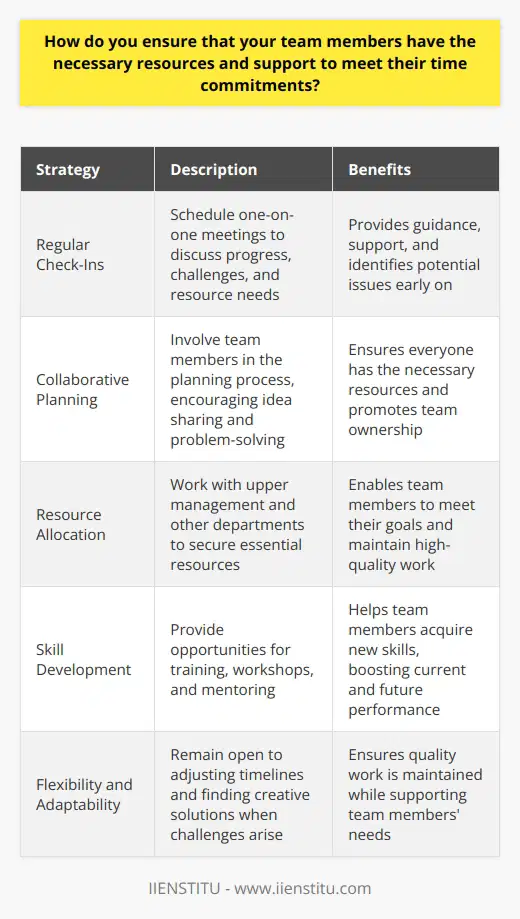
What steps do you take to identify and address potential bottlenecks or delays in your team's workflow?
I believe in being proactive when it comes to identifying and addressing potential bottlenecks or delays in my team's workflow. From my experience, communication is key to keeping everyone on the same page and ensuring smooth progress.
Regular Check-Ins
I make it a point to have regular check-ins with my team members. These meetings allow us to discuss current projects, identify any challenges or roadblocks, and brainstorm solutions together. By fostering open communication, we can catch potential issues early on and take steps to mitigate them.
Prioritizing Tasks
Another crucial aspect of preventing bottlenecks is prioritizing tasks effectively. I work with my team to assess the urgency and importance of each task, ensuring that we tackle high-priority items first. This helps us avoid getting stuck on less critical tasks that could delay the overall workflow.
Monitoring Progress
I also believe in closely monitoring the progress of our projects. By keeping a watchful eye on timelines, deadlines, and milestones, I can quickly spot any potential delays or bottlenecks. If I notice that a particular task is taking longer than expected or a team member is struggling, I step in to offer support and guidance.
Continuous Improvement
Finally, I'm a big advocate of continuous improvement. After each project, I gather feedback from my team to identify areas where we can streamline our processes and workflows. By constantly refining our approach, we can prevent bottlenecks from occurring in the first place and ensure that our team operates at peak efficiency.
At the end of the day, identifying and addressing potential bottlenecks is all about staying vigilant, communicating effectively, and being proactive in our problem-solving efforts.
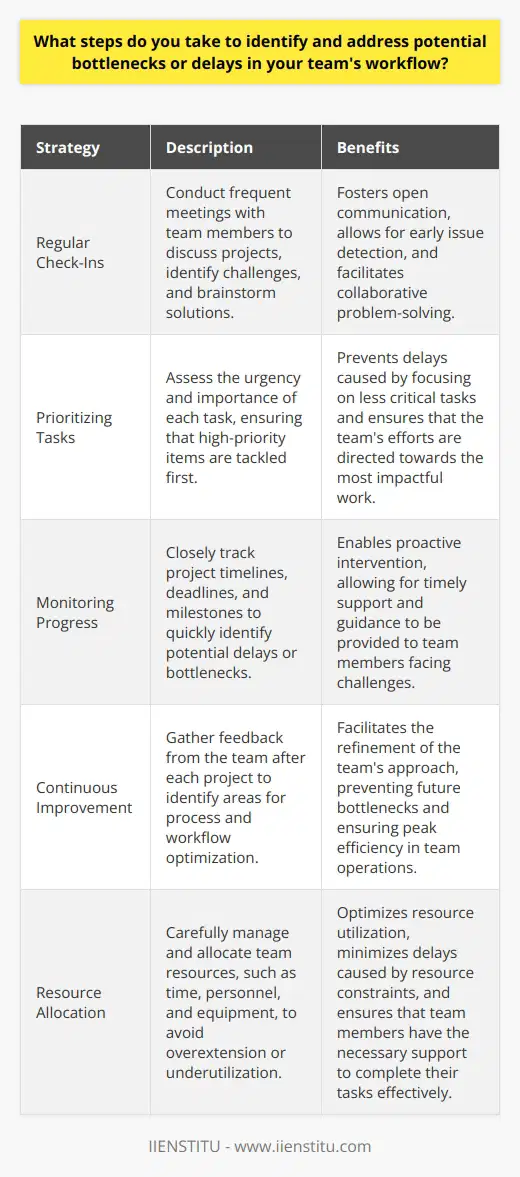
How do you foster open communication within your team to ensure that everyone is aware of deadlines and expectations?
I foster open communication within my team by prioritizing transparency and setting clear expectations from the outset. During our initial team meeting, I outline the project goals, deadlines, and individual responsibilities. This ensures that everyone is on the same page and understands their role in achieving our objectives.
Encouraging Regular Check-Ins
Throughout the project, I schedule regular check-ins with each team member. These one-on-one meetings provide an opportunity to discuss progress, address any challenges, and offer support. By creating a safe space for open dialogue, team members feel comfortable sharing their concerns and seeking guidance when needed.
Leveraging Collaboration Tools
To facilitate effective communication, I leverage collaboration tools like Slack and Trello. These platforms allow for real-time updates, file sharing, and project tracking. By centralizing information and communication, everyone stays informed and aligned, even when working remotely or across different time zones.
Celebrating Milestones and Successes
I believe in celebrating milestones and recognizing individual and team successes. When we hit a major deadline or overcome a significant challenge, I make sure to acknowledge the hard work and dedication of my team. This boosts morale, strengthens team bonds, and reinforces the importance of open communication in achieving our goals.
By fostering a culture of transparency, setting clear expectations, and providing regular opportunities for feedback and collaboration, I ensure that my team remains informed, engaged, and motivated to deliver their best work.
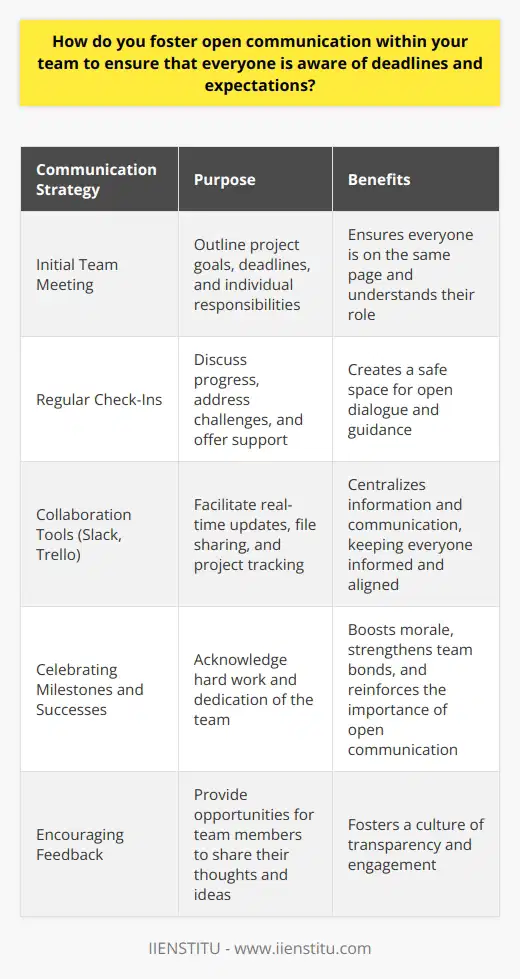
What methods do you use to celebrate and acknowledge your team's successes in meeting deadlines and managing their time effectively?
I believe in recognizing and celebrating the team's accomplishments, both big and small. When we meet a deadline or manage our time well, I make sure to acknowledge it.
Verbal Recognition
I start by verbally praising the team during our meetings. I highlight specific achievements and the people responsible for them. This boosts morale and encourages everyone to keep up the great work.
Sharing Success Stories
I also share our success stories with the rest of the company through internal newsletters or announcements. This lets other departments know about our team's hard work and dedication.
Rewards and Incentives
In addition to verbal recognition, I believe in offering tangible rewards for exceptional performance. This could be anything from gift cards to extra time off. It shows that I value their efforts and want to give back.
Team Celebrations
When we wrap up a big project or hit a major milestone, I organize team celebrations. We might have a special lunch, happy hour, or even a fun outing. It's a chance to relax, bond, and reflect on our achievements.
Continuous Improvement
Finally, I use our successes as learning opportunities. We discuss what went well and what we could improve for next time. This helps us grow as a team and tackle future challenges more effectively.
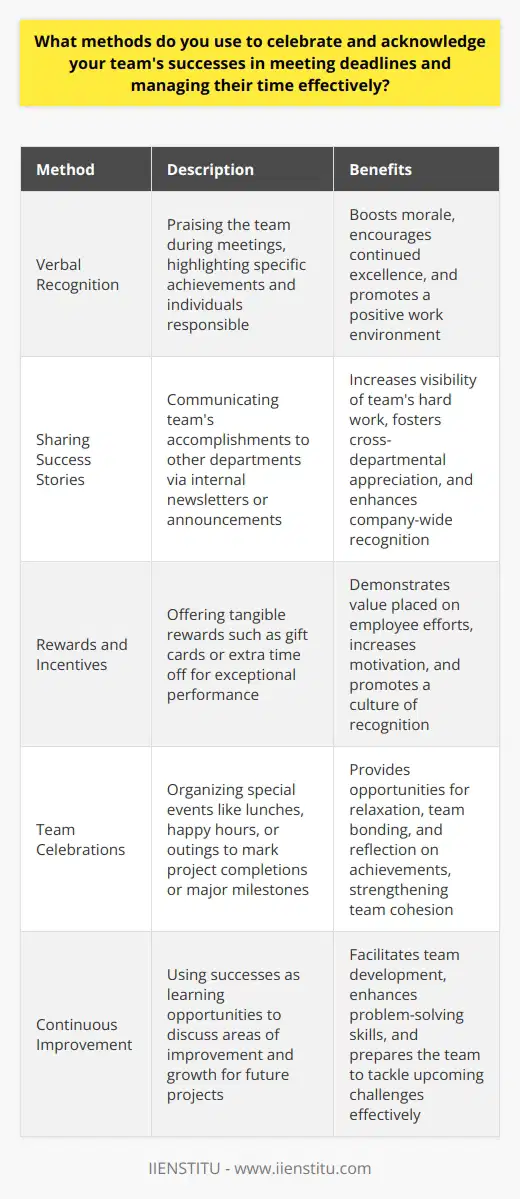
How do you handle situations where external factors, such as client demands or unexpected setbacks, impact your team's time management?
When external factors impact my team's time management, I first assess the situation calmly and objectively. I gather all the relevant information and identify the root cause of the issue.
Prioritizing Tasks
Next, I prioritize tasks based on urgency and importance. I focus on delivering the most critical deliverables first. I also communicate openly with clients or stakeholders, setting realistic expectations and proposing alternative solutions if necessary.
Adapting the Plan
I adapt our project plan to accommodate the new challenges. This might involve reallocating resources, adjusting timelines, or finding creative workarounds. I try to be flexible and proactive, anticipating potential obstacles and having contingency plans ready.
Supporting the Team
Throughout the process, I support and motivate my team. I recognize that unexpected changes can be stressful, so I stay positive and encouraging. I make sure everyone has the resources and guidance they need to succeed despite the challenges.
Learning from Experience
After the situation is resolved, I take time to reflect and learn from the experience. I analyze what worked well and what could be improved. I share these insights with my team so we can handle future challenges even better.
In summary, I approach time management challenges with a calm, adaptive, and supportive mindset. By prioritizing wisely, staying flexible, and learning continuously, I help my team navigate external pressures successfully.
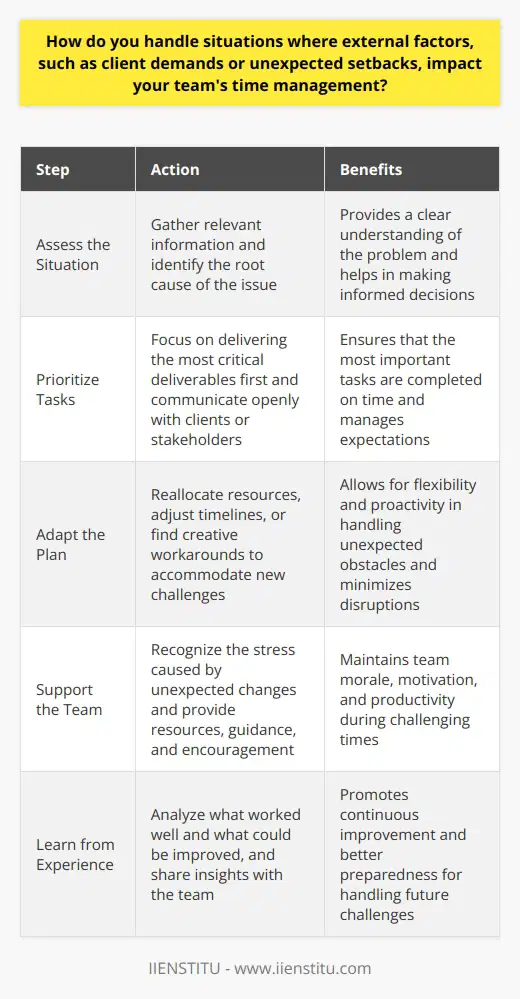
What strategies do you employ to ensure that your team's time management aligns with the overall goals and objectives of the organization?
As a team leader, I understand the importance of effective time management in achieving organizational goals. Here are some strategies I employ to ensure my team's time management aligns with the company's objectives:
Prioritizing Tasks
I work with my team to identify and prioritize tasks that directly contribute to the organization's goals. We regularly review our to-do lists and adjust priorities as needed, ensuring that we're always focusing on the most critical tasks.
Setting Clear Deadlines
I set clear deadlines for each task and project, taking into account the team's workload and the organization's timeline. This helps us stay on track and ensures that we're making steady progress towards our goals.
Encouraging Open Communication
I foster an environment of open communication within my team. We have regular check-ins and meetings to discuss progress, challenges, and any need for support. This helps us identify and address any time management issues before they become major problems.
Leading by Example
I believe in leading by example when it comes to time management. I make sure to prioritize my own tasks, meet deadlines, and communicate effectively with my team and other departments. By modeling good time management habits, I inspire my team to do the same.
By implementing these strategies, I've been able to help my team consistently meet deadlines and contribute to the organization's success. In my previous role, for example, we were able to complete a major project two weeks ahead of schedule by prioritizing tasks, setting clear deadlines, and communicating openly throughout the process. It was a proud moment for me and my team, and it demonstrated the power of effective time management.
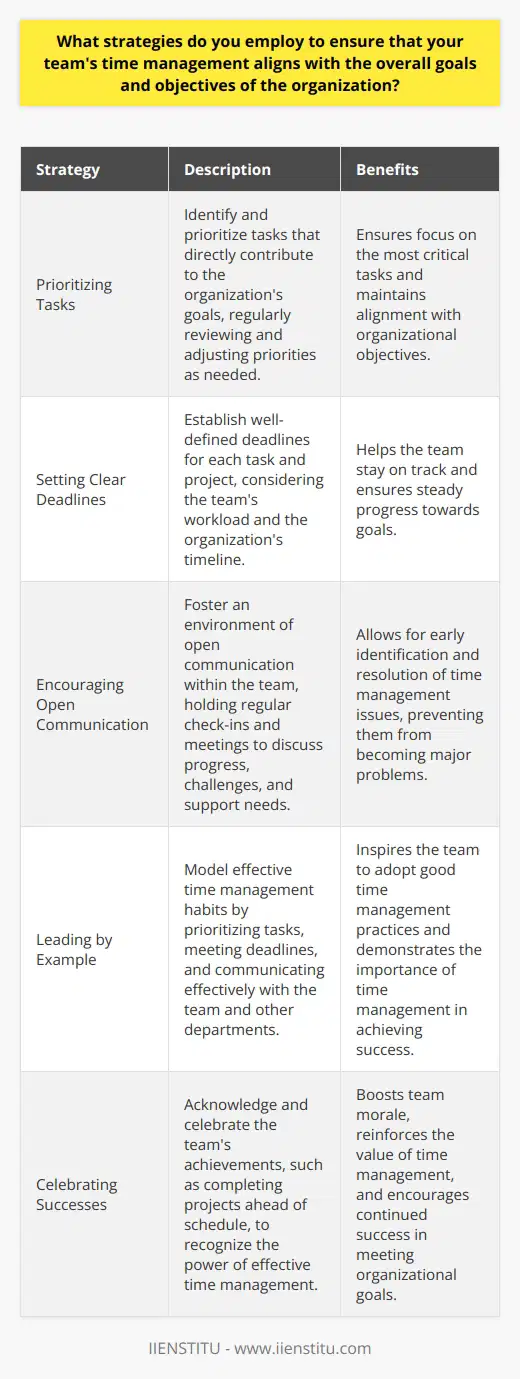
How do you encourage your team members to take ownership of their time management and develop their skills in this area?
I encourage my team members to take ownership of their time management by setting a positive example myself. I prioritize tasks, meet deadlines, and communicate effectively about my progress and challenges. This demonstrates the importance of personal responsibility and accountability in managing one's time.
Providing Tools and Resources
I make sure my team has access to the tools and resources they need to effectively manage their time. This includes project management software, time tracking apps, and educational materials on time management techniques. By equipping them with the right tools, I empower them to take control of their schedules.
Encouraging Goal Setting and Planning
I encourage my team members to set clear goals for themselves and break them down into manageable tasks. We have regular check-ins where we discuss their progress, identify any obstacles, and brainstorm solutions together. This collaborative approach helps them develop their planning and problem-solving skills.
Promoting a Culture of Learning and Growth
I foster a team culture that values continuous learning and personal development. I share articles, books, and training opportunities related to time management and productivity. We also have team discussions where we share our experiences, tips, and lessons learned. By creating an environment that supports growth, I inspire my team to actively develop their skills.
Recognizing and Rewarding Success
When team members demonstrate effective time management and make notable progress on their goals, I make sure to recognize and celebrate their achievements. Whether it's a shout-out in a team meeting or a personalized note of appreciation, acknowledging their efforts reinforces the importance of taking ownership of their time and skills.
By providing guidance, resources, and a supportive environment, I empower my team to become proactive time managers and continuously develop their abilities in this crucial area.
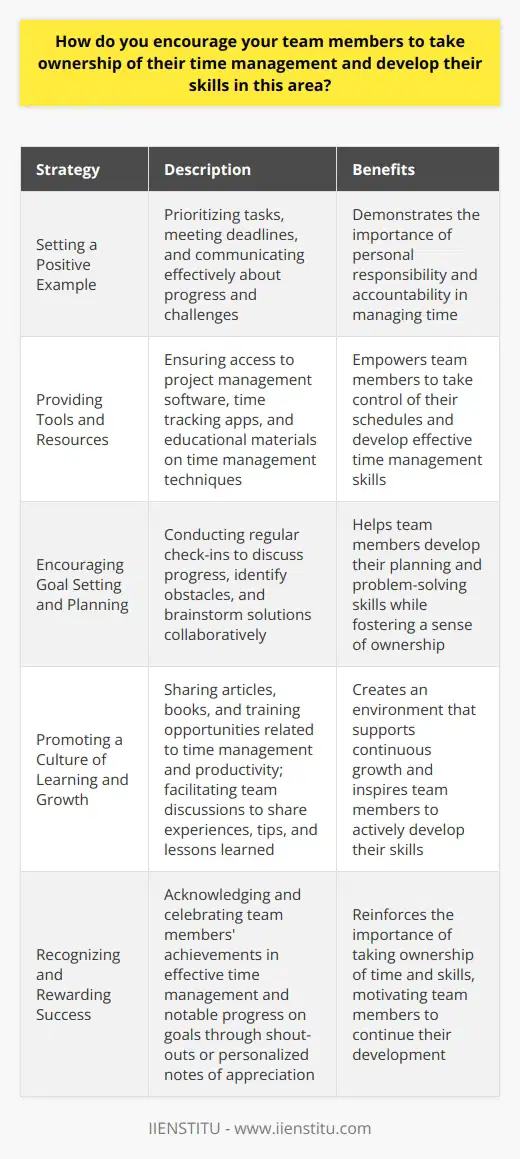
What techniques do you use to facilitate effective time management during team meetings and discussions?
Prioritizing Effective Time Management in Team Meetings
When it comes to facilitating effective time management during team meetings and discussions, I have a few go-to techniques. First and foremost, I always make sure to set a clear agenda beforehand. This helps keep everyone focused and on track.
Assigning Time Limits for Each Topic
Another strategy I like to use is assigning specific time limits for each topic on the agenda. This prevents discussions from dragging on too long and ensures we cover everything we need to. I also encourage team members to come prepared with any questions or concerns they want to address.
Encouraging Active Participation and Open Communication
During the meeting itself, I try to foster an environment of active participation and open communication. I believe it's important for everyone to have a chance to share their thoughts and ideas. At the same time, I keep an eye on the clock and gently redirect the conversation if we start to veer off topic.
Summarizing Key Points and Action Items
As we wrap up each agenda item, I make a point to summarize the key points and any action items that were decided upon. This helps ensure everyone is on the same page and knows what needs to be done moving forward.
Overall, I've found that a combination of careful planning, clear communication, and a bit of flexibility goes a long way in making team meetings productive and efficient.
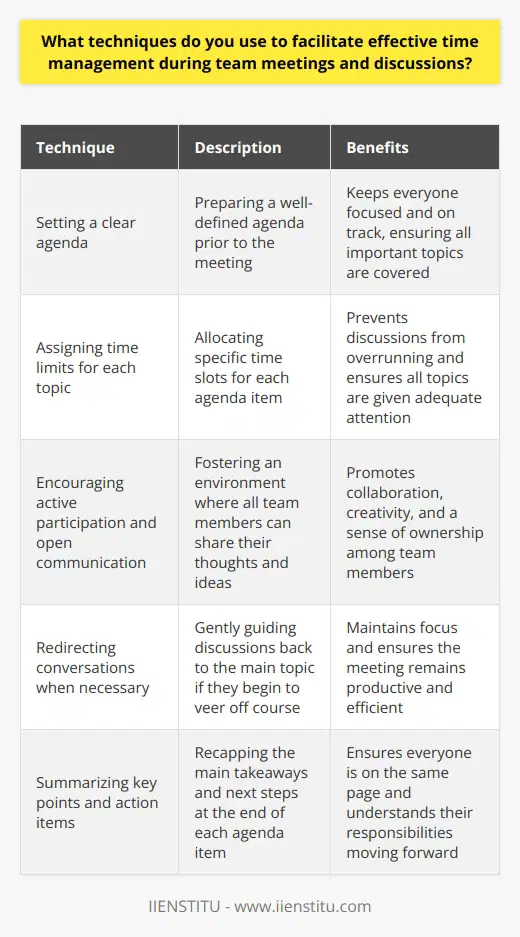
How do you ensure that your team's time management practices are continuously reviewed and improved?
I believe that effective time management is crucial for any team's success. To ensure that our team's time management practices are continuously reviewed and improved, I follow a few key strategies:
Regular Check-Ins and Feedback
I schedule regular check-ins with my team members to discuss their workload, priorities, and any challenges they're facing. During these meetings, I encourage open and honest feedback about our current time management practices. We identify areas that are working well and those that need improvement. This ongoing dialogue helps us stay aligned and adapt our approach as needed.
Encouraging a Culture of Continuous Improvement
I strive to foster a team culture that values continuous improvement. I encourage my team members to share their ideas and suggestions for optimizing our time management strategies. When someone proposes a new approach or tool, we discuss it as a team and decide whether to implement it. By empowering everyone to contribute to the process, we create a sense of ownership and accountability.
Leveraging Technology and Tools
I'm always on the lookout for new tools and technologies that can help us work more efficiently. Whether it's a project management software, a time tracking app, or a collaboration platform, I explore options that can streamline our workflows and eliminate unnecessary tasks. When we find a tool that works well for us, we integrate it into our daily routines and continuously assess its effectiveness.
Leading by Example
As a team leader, I believe in leading by example. I make a conscious effort to model good time management practices myself. I prioritize my tasks, minimize distractions, and communicate clearly with my team. By demonstrating effective time management in my own work, I set the tone for the rest of the team to follow.
Ultimately, ensuring that our team's time management practices are continuously reviewed and improved is an ongoing process. It requires open communication, a willingness to experiment with new approaches, and a commitment to learning and growing together. By staying proactive and adaptable, we can optimize our productivity and achieve our goals more efficiently.
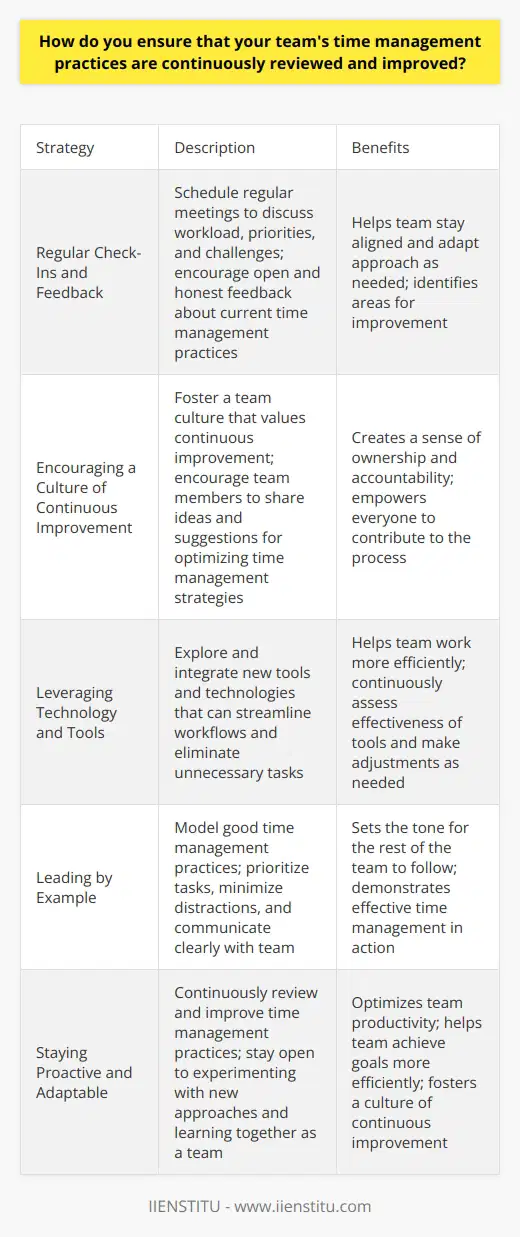
What methods do you use to help your team members prioritize their individual tasks and responsibilities?
As a team leader, I employ several methods to help my team members prioritize their tasks and responsibilities effectively. One key approach is to conduct regular one-on-one meetings with each team member. During these meetings, we discuss their current workload, identify urgent and important tasks, and develop a plan to tackle them in order of priority.
Setting Clear Goals and Deadlines
I work closely with my team to set clear, achievable goals for each project or task. We break down larger projects into smaller, manageable tasks and assign realistic deadlines. This helps team members understand exactly what is expected of them and when it needs to be completed.
Encouraging Open Communication
I foster an open and transparent communication environment within the team. Team members feel comfortable discussing any challenges or roadblocks they encounter. We brainstorm solutions together and adjust priorities as needed. This collaborative approach ensures that everyone is on the same page and working towards common objectives.
Utilizing Project Management Tools
I introduce project management tools like Trello or Asana to help visualize and organize tasks. These tools allow team members to see their individual responsibilities, deadlines, and progress in one place. They can easily prioritize their workload and stay on track.
Leading by Example
I believe in leading by example. I prioritize my own tasks and responsibilities effectively and share my strategies with the team. When team members see their leader managing their time and workload well, they are more likely to follow suit.
By implementing these methods consistently, I have seen my team members become more organized, focused, and productive. They feel empowered to take ownership of their tasks and contribute to the team's success.
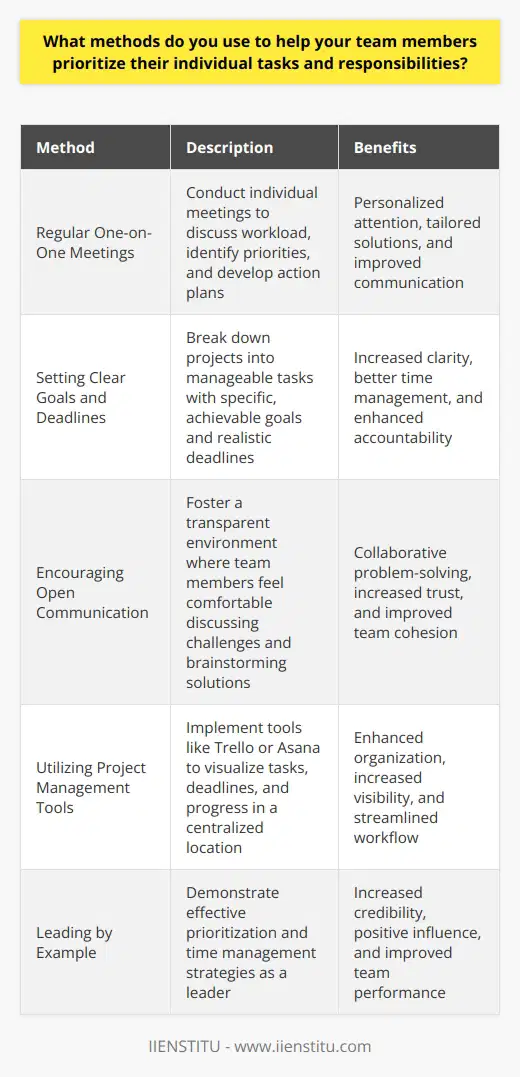
How do you handle situations where team members have conflicting priorities or deadlines?
When faced with conflicting priorities or deadlines within a team, I believe open communication is key. I always strive to understand each team member's perspective and the reasoning behind their priorities. This helps me gain a comprehensive view of the situation and find common ground.
Collaborating to Find Solutions
Once I have a clear understanding of everyone's needs, I work collaboratively with the team to brainstorm solutions. We discuss various options and assess their feasibility, considering factors like time constraints, resources, and potential impact. By involving the entire team in the problem-solving process, we can generate creative ideas and reach a consensus.
Prioritizing and Compromising
In some cases, it may be necessary to prioritize tasks based on their urgency and importance. I help the team evaluate each task objectively and determine which ones should take precedence. However, I also believe in finding compromises whenever possible. If two tasks are equally important, we might explore ways to adjust timelines or reallocate resources to accommodate both.
Leading by Example
As a team member, I lead by example and maintain a positive attitude even in challenging situations. I encourage open dialogue, active listening, and a focus on finding solutions rather than dwelling on problems. By fostering a supportive and collaborative environment, I find that conflicts can be resolved more effectively.
Continuous Improvement
After navigating a situation with conflicting priorities or deadlines, I believe in reflecting on the experience and identifying areas for improvement. Did we communicate effectively? Were there any bottlenecks or inefficiencies? By learning from each challenge, we can continuously enhance our team's ability to handle similar situations in the future.
In summary, when faced with conflicting priorities or deadlines, I prioritize open communication, collaboration, and a solution-oriented mindset. By working together and maintaining a positive attitude, I believe teams can successfully navigate challenges and deliver high-quality results.
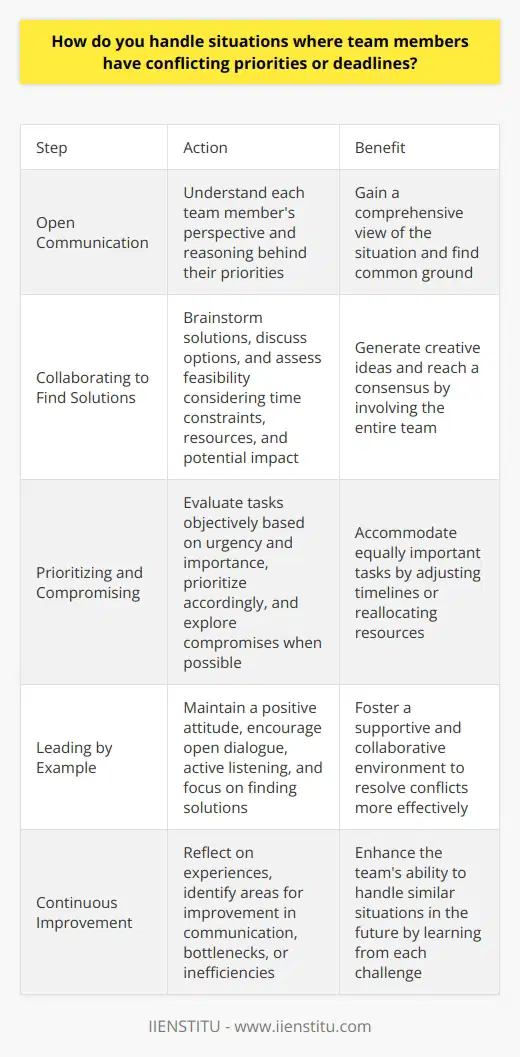
What strategies do you implement to ensure that your team's time management practices are scalable and adaptable to changing circumstances?
As a team leader, I believe that effective time management is crucial for achieving our goals. To ensure that our time management practices are scalable and adaptable, I implement several strategies:
Setting Clear Priorities
I work with my team to identify the most important tasks and projects. We prioritize based on urgency, impact, and alignment with our overall objectives. This helps us focus our time and energy on what matters most.
Example:
In my previous role, we had a tight deadline for a client project. I sat down with my team and we determined which tasks were critical for meeting the deadline. We then allocated our resources accordingly and were able to deliver the project on time.
Encouraging Open Communication
I foster an environment where team members feel comfortable sharing their workload and any challenges they're facing. Regular check-ins and open discussions help us identify potential bottlenecks and adjust our plans as needed.
Personal Experience:
I once had a team member who was struggling to keep up with their tasks. By having an honest conversation, we discovered that they were overloaded and needed support. We redistributed some of their work and provided additional training, which improved their efficiency and morale.
Embracing Flexibility
I understand that circumstances can change quickly, so I encourage my team to be adaptable. We regularly review our processes and are open to trying new approaches if something isn't working.
Example:
During the pandemic, we had to shift to remote work unexpectedly. I worked with my team to adjust our communication channels and workflows to ensure we could still collaborate effectively. It required flexibility and creativity, but we were able to maintain our productivity.
Overall, I believe that by setting clear priorities, fostering open communication, and embracing flexibility, we can create time management practices that are scalable and adaptable to any situation.

How do you foster a culture of transparency and honesty within your team regarding time constraints and challenges?
I believe that transparency and honesty are essential for building trust within a team. When it comes to time constraints and challenges, I make it a point to communicate openly with my team members.
Leading by Example
I foster a culture of transparency by being transparent myself. I share my own struggles and challenges with the team, showing them that it's okay to be vulnerable and ask for help when needed.
Regular Check-Ins
I schedule regular one-on-one meetings with each team member to discuss their workload and any challenges they may be facing. This allows me to stay informed about their progress and provide support where needed.
Encouraging Open Communication
During team meetings, I encourage everyone to speak up and share their concerns or ideas. I create a safe space where team members feel comfortable being honest about their workload and any obstacles they may be facing.
Celebrating Transparency
When a team member is transparent about a challenge or mistake, I make sure to acknowledge and appreciate their honesty. This reinforces the idea that transparency is valued and encouraged within the team.
In my experience, fostering a culture of transparency and honesty leads to better collaboration, problem-solving, and ultimately, better results. It's not always easy, but it's worth the effort to build a team that trusts and supports one another.
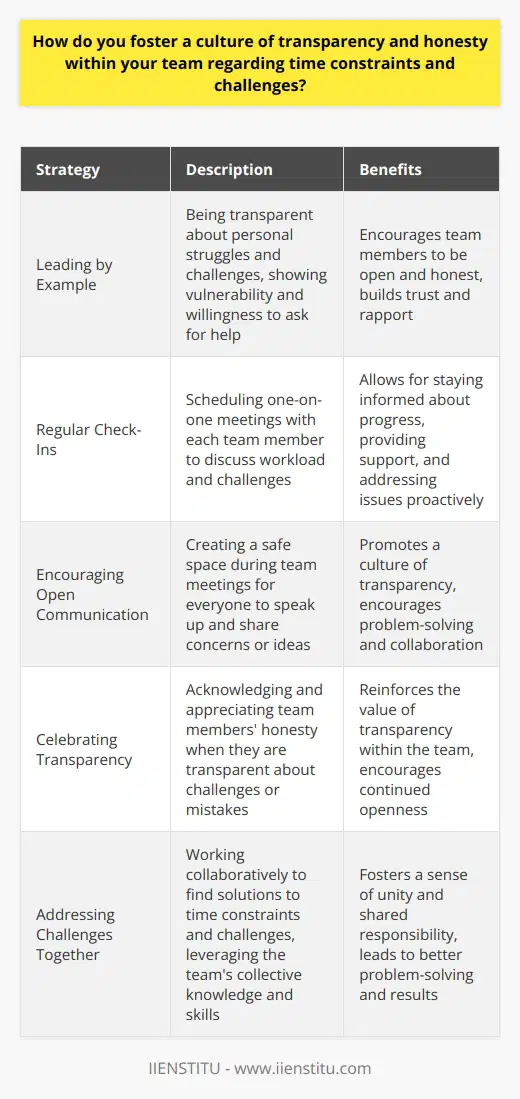
What techniques do you use to ensure that your team's time management practices align with industry best practices and standards?
When it comes to ensuring that my team's time management practices align with industry best practices and standards, I employ several techniques. First and foremost, I lead by example. I make sure to prioritize my own tasks effectively and efficiently, showing my team the importance of good time management.
Setting Clear Goals and Expectations
I work with my team to set clear, achievable goals and expectations for each project. We break down larger tasks into smaller, manageable steps and assign realistic deadlines. This helps us stay on track and avoid last-minute rushes.
Regular Check-Ins and Progress Updates
I schedule regular check-ins with my team members to discuss their progress, challenges, and any support they need. These check-ins help me identify potential roadblocks early on and provide guidance or resources to keep everyone on schedule.
Encouraging Open Communication and Collaboration
I foster an environment of open communication and collaboration within my team. We use project management tools like Trello or Asana to keep everyone informed and on the same page. This transparency helps us identify areas where we can improve our time management and support each other.
Continuous Learning and Improvement
I believe in continuous learning and improvement. I stay up-to-date with industry best practices and standards through workshops, webinars, and professional development opportunities. I encourage my team to do the same and share their insights with the group. By constantly refining our time management skills, we can deliver high-quality work efficiently and effectively.
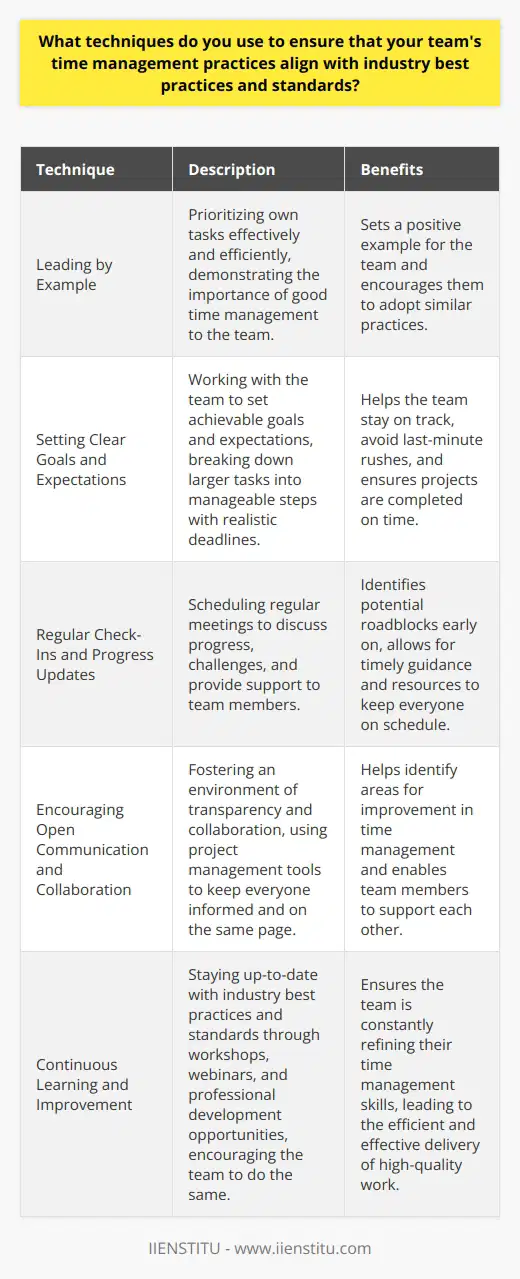
How do you handle situations where a team member consistently underestimates the time required for their tasks?
When faced with a team member who consistently underestimates the time needed for their tasks, I take a proactive approach. First, I initiate an open and honest discussion with the individual to understand their perspective and challenges. During this conversation, I actively listen and offer empathy to build trust and rapport.
Identifying Root Causes
Next, I work with the team member to identify the root causes behind their underestimation. This may involve reviewing past projects, analyzing their estimation process, and considering external factors that might impact their ability to accurately assess task durations. By collaboratively examining these factors, we can pinpoint areas for improvement.
Providing Guidance and Support
Once we have a clear understanding of the issues, I provide guidance and support to help the team member refine their estimation skills. This may include sharing best practices, offering tools and techniques for breaking down tasks, and encouraging them to seek input from experienced colleagues. I also emphasize the importance of regularly reviewing progress and making necessary adjustments along the way.
Fostering a Culture of Transparency
Throughout the process, I strive to foster a team culture that values transparency, accountability, and continuous improvement. I encourage open communication and create a safe space for team members to voice concerns, share challenges, and celebrate successes. By promoting a supportive and collaborative environment, we can work together to overcome obstacles and deliver high-quality results.
Ultimately, my goal is to empower the team member to develop more accurate estimation skills while maintaining a positive and productive working relationship. By addressing the issue with empathy, providing targeted support, and fostering a growth mindset, I believe we can successfully navigate these situations and strengthen our team's overall performance.
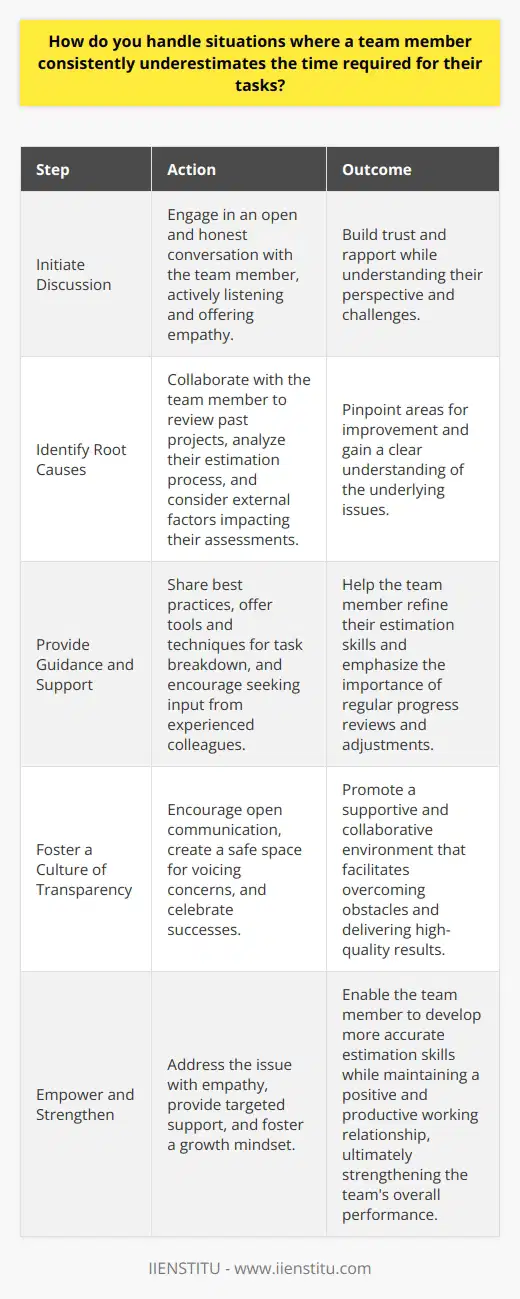
What methods do you use to ensure that your team's time management practices support a positive and productive work environment?
As a team leader, I prioritize effective time management to foster a positive and productive work environment. I believe that clear communication is key to ensuring everyone is on the same page.
Setting Clear Goals and Expectations
I work with my team to set specific, achievable goals for each project. We break down larger tasks into smaller, manageable steps and assign deadlines to keep everyone accountable. By clearly defining expectations upfront, we minimize confusion and ensure smooth progress.
Encouraging Open Communication
I maintain an open-door policy and encourage my team to voice their concerns or challenges. We have regular check-ins to discuss progress, identify roadblocks, and brainstorm solutions together. This helps us quickly address any time management issues before they escalate.
Utilizing Productivity Tools
I'm a big fan of using productivity tools to streamline our workflow. We use project management software to track tasks, deadlines, and dependencies. This gives everyone visibility into the team's progress and helps us identify potential bottlenecks early on.
Promoting Work-Life Balance
I understand that a healthy work-life balance is crucial for long-term productivity and well-being. I encourage my team to take regular breaks, disconnect after work hours, and use their vacation time. By modeling good time management habits myself, I set the tone for a positive and supportive work culture.
